Astronomical League's page for the Planetary Nebula Program I completed the Basic award (certificate only - 60 objects), not the Advanced (which gives you a pin - all 110 objects) The program was developed by our club the Back Bay Amateur Astronomers and members are encouraged to do the program - so I am! There are many objects in the 110 object list that I think are too difficult for my modest 8" scope. I found that viewing 60 of the objects was a pretty significant challenge and I had to work pretty hard to do that. The quality of my observations improved as I worked my way through the program.
Observation Sites used to complete this program in order of Sky Quality
| Name | Lat/Long (decimal) | Sky Quality | Bortle Class |
|---|---|---|---|
| Home | 36.71,-76.19 | 19.36 | Class 6 |
| Cornland Park, Chesapeake, VA | 36.63,-76.32 | 20.52 | Class 4 |
| Northwest River Park, Chesapeake, VA | 36.59,-76.16 | 20.72 | Class 4 |
| Chippokes State Park, VA | 37.14,-76.72 | 20.83 | Class 4 |
| Marsh Causeway Knotts Island, NC | 36.54,-75.96 | 21.44 | Class 4 |
| Staunton River State Park, VA | 36.70,-78.68 | 21.66 | Class 4 |
| James River State Park, VA | 37.63, -78.81 | 21.81 | Class 3 |
Telescope Used
All observations made with an 8" Celestron NexStar Evolution Telescope. Aperture 8" (203mm), Focal Length 2033mm, F/10Eyepiece Magnifications
| Eyepiece | Magnification | FOV (field of view) |
|---|---|---|
| 40mm ES68 2" | 51x | 1.34° or 80' |
| 24mm ES68 1.25" | 85x | 0.8° or 48' |
| 14mm TeleVue Delos 1.25" | 145x | 0.5° or 30' |
| 10mm TeleVue Delos 1.25" | 203x | 0.35° or 21' |
| Celestron Finder Scope | 9x | 5° |
Filters I Used For This Program
| Filter Name |
|---|
| Orion Ultrablock UHC |
| Orion OIII |
| Orion SkyGlow |
My custom Planetary Nebula observation form on a small clip board with red light. The form is folded and on the opposite of the fold is a template for a sketch. On most completed forms writing is very messy since I am taking notes at the eyepiece in the dark under a red light.

Summary of Planetary Nebulas that have been observed
As of 09/17/2023 I have completed 61 of the 60 objects needed to obtain a certificate.
First observation for this program was on 03/01/2022 completed the 60th observation on 09/14/2023 at the Chippokes East Coast Star Party.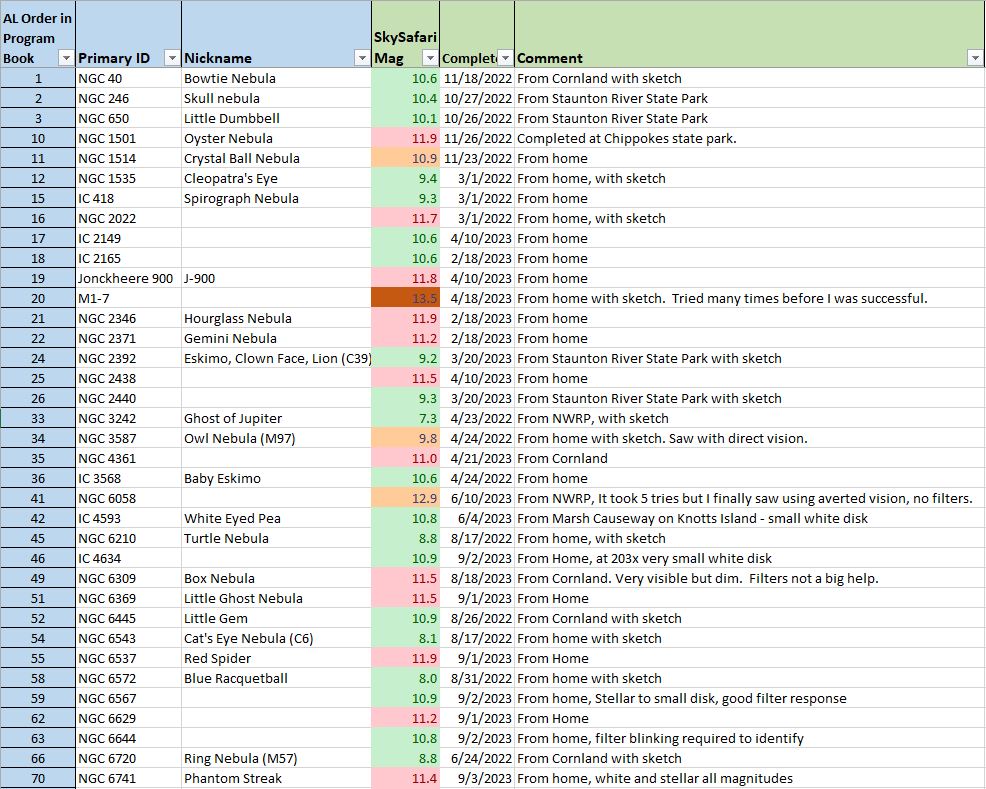
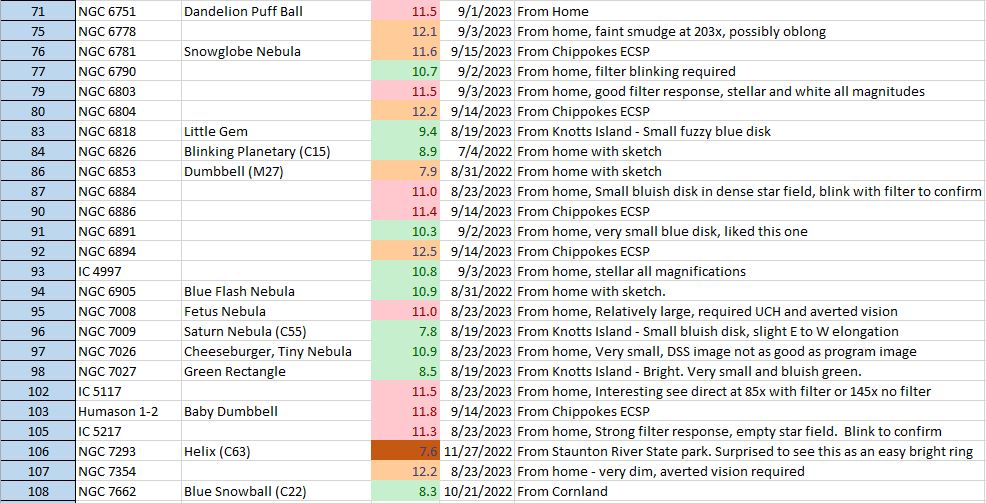
AL #1 (pg26) - NGC 40 "Bowtie Nebula" or "Scarab Nebula"
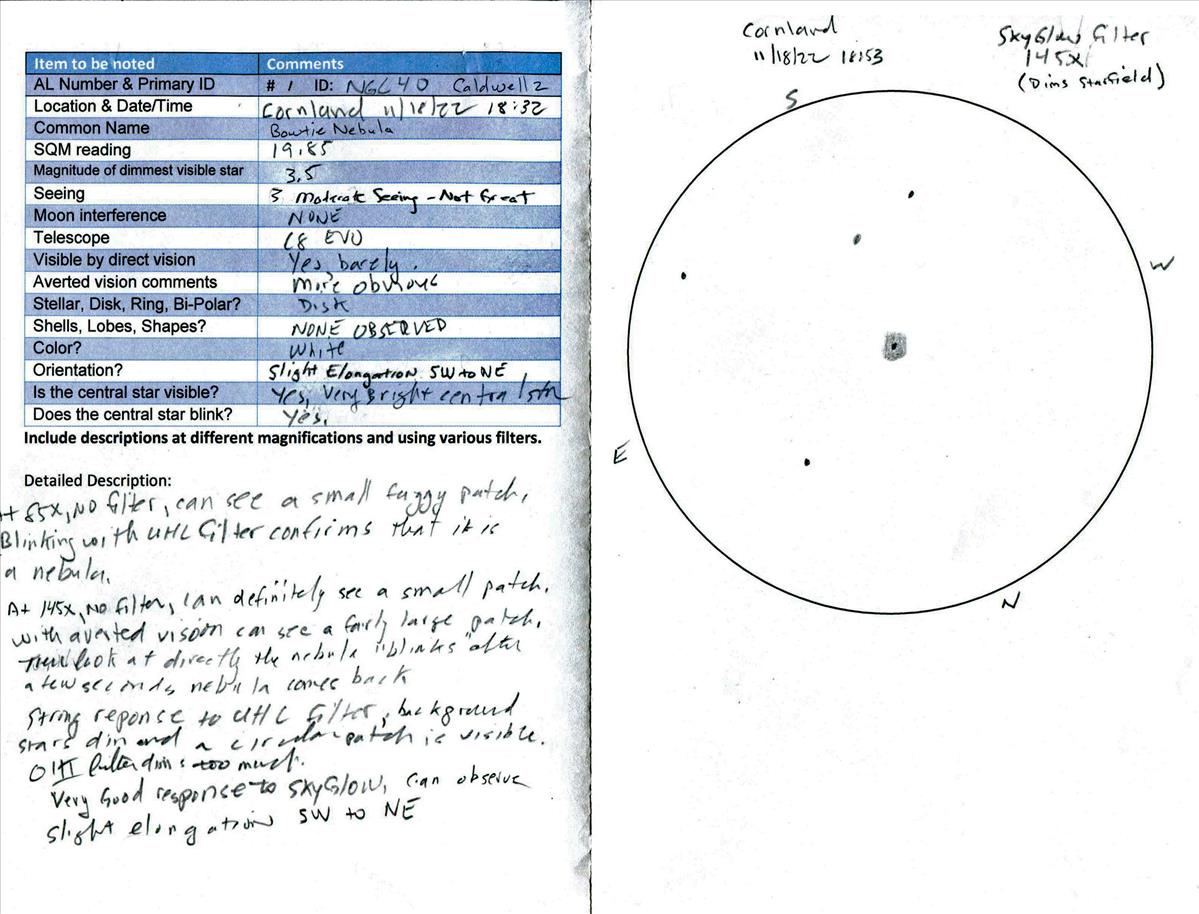
Spent 20 minutes making observation notes then another 5 minutes making a sketch. At 85x with no filter I could see a small fuzzy white patch. Blinking between no filter and the Ultrablock narrowband filter confirmed this was a planetary nebula. At 145x with no filter could definitely see a small disk like patch with a bright central star. Averted vision was definitely helpful to observe the blinking effect which was clearly present. Good response toUltracblock filter but OIII dimmed the object too much to be useful. The SkyGlow filter gave a very good response and was used to make a sketch of the object. There was a slight elongation from SW to NE.
AL #2 (pg26) - NGC 246; C56 "Skull Nebula"
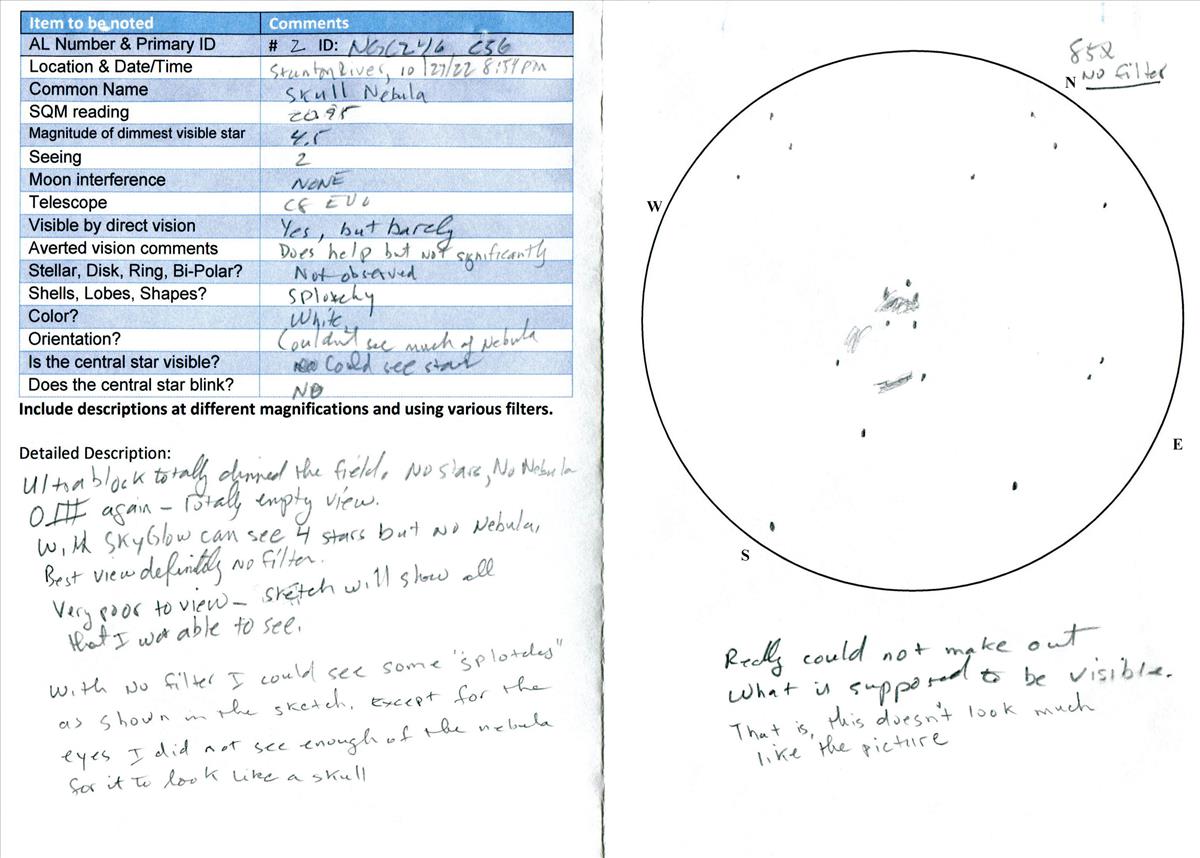
I have looked at this object several times before making this observation and it never lives up to what I "want" to see. It was a pretty large object so I only observed it at 85x. I could see the skull's "eyes" and some splotchyness but did not see the skull shape. The Ultrablock narrowband filter dimmed the field - didn't see any stars or the nebula. With the SkyGlow I could see 4 stars but not the nebula. Best view was definitely with no filters and averted vision helped a little. As can be seen in the sketch I only saw parts of the nebula and it definitely did not look like a skull.
AL #3 (pg26) - NGC 650-1; M76 "Little Dumbbell"
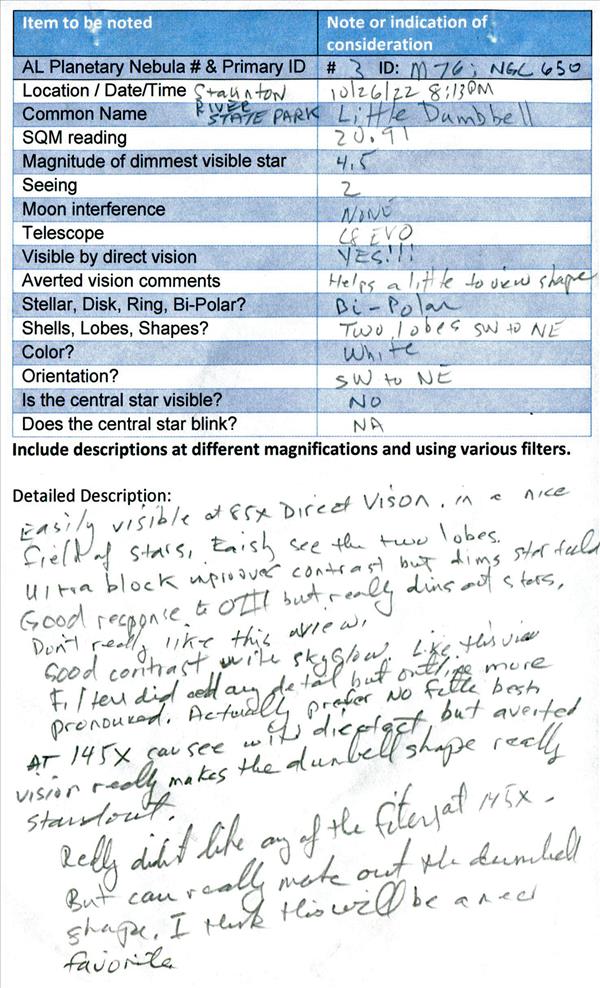
Easily visible at 85x with direct vision in a nice field of stars. Could easily see two lobes. Another object that really surprised me at how good it looked. Ultrablock narrowband, OIII and SkyGlow filters all improved the contrast but dimmed out the stars. I really preferred this object with no fitler. Was ok at 85x but looked better at 145x where the lobes where more clearly defined. Using averted vision really made the lobes stand out. This object will be going into my favorites list - a real treat to have discovered this object.
AL #10 (pg29) - NGC 1501 "Oyster or Camel's Eye Nebula"
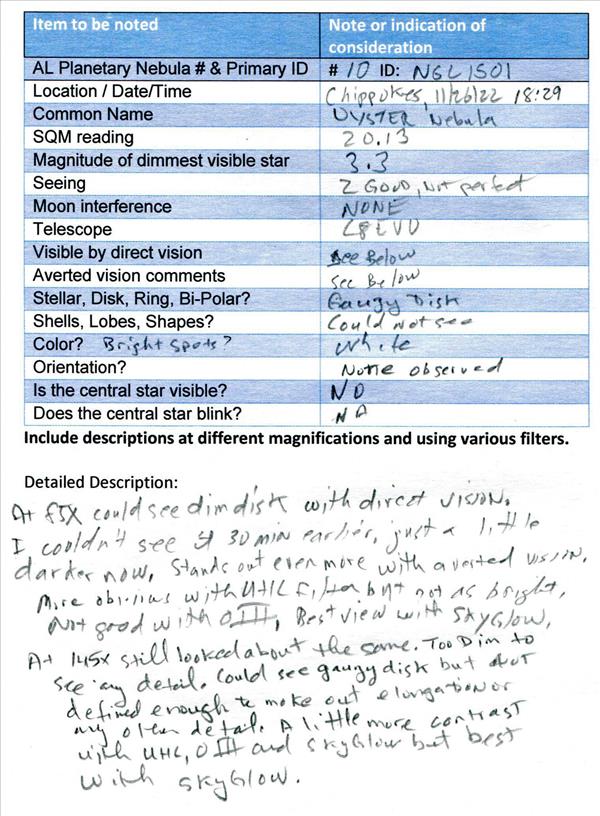
Thirty minutes earlier I could not make this out but now it is nautical dusk and a little darker and I could make it out. At 85x I could see a very dim gauzy disk with direct vision. Stands out even more with averted vision. With these very dim objects I just cannot make out any detail - they are like ghosts and you see something but cannot make out details. Object is more noticable with Ultrablock filter (due to increased contrast with the dimmed object) but not as bright. The OIII filter just dims everything too much to be useful on this object. Best view was with the SkyGlow filter - again this filter really impresses. At 145x the object looked pretty much the same just a little larger and even more dim. This magnification did not help at all in viewing the object. I could not make out any elongation and did not see a central star. Since I couldn't really make out any detail I did not sketch the object.
AL #11 (pg29) - NGC 1514 "Crystal Ball"
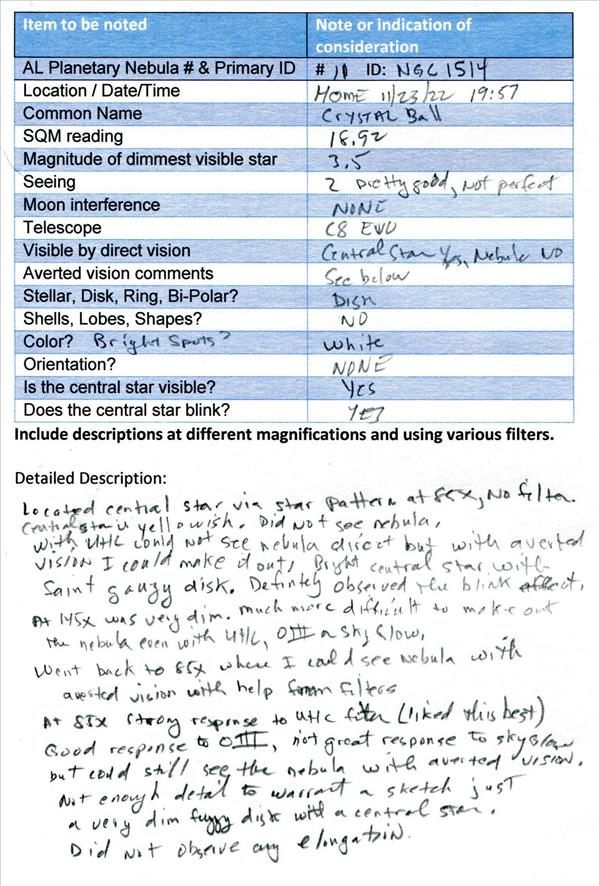
At 85x, with no filter, I confirmed what I was looking at via star pattern. There was a pretty bright yellow central star but I did not see the nebula with either direct or averted vision. With Ultrablock narrowband filter I could not with direct vision but I could see it using indirect vision as a faint gauzy disk. I could definitely observe a blinking effect where the central star momentarily overwhelmed the nebula. At 145x it was more difficult to make out the nebula due to increased dimming. At 145x I could see the nebula when using the Ultrablock and the SkyGlow filters - the OIII filter dimmed the object too much and I could not make out the nebula. Went back to 85x which offered the best view using averted vision and a nebula filter. Strong response with Ultrablock and SkyGlow filters; the OIII filter was just too dim to make out the nebula. Smokey, guazy disk appeared to be circular - I did not observe any elongation. Even with averted vision the nebula was just too dim to make out much detail so I did decided not to make a sketch.
AL #12 (pg29) - NGC 1535 "Cleopatra's Eye"
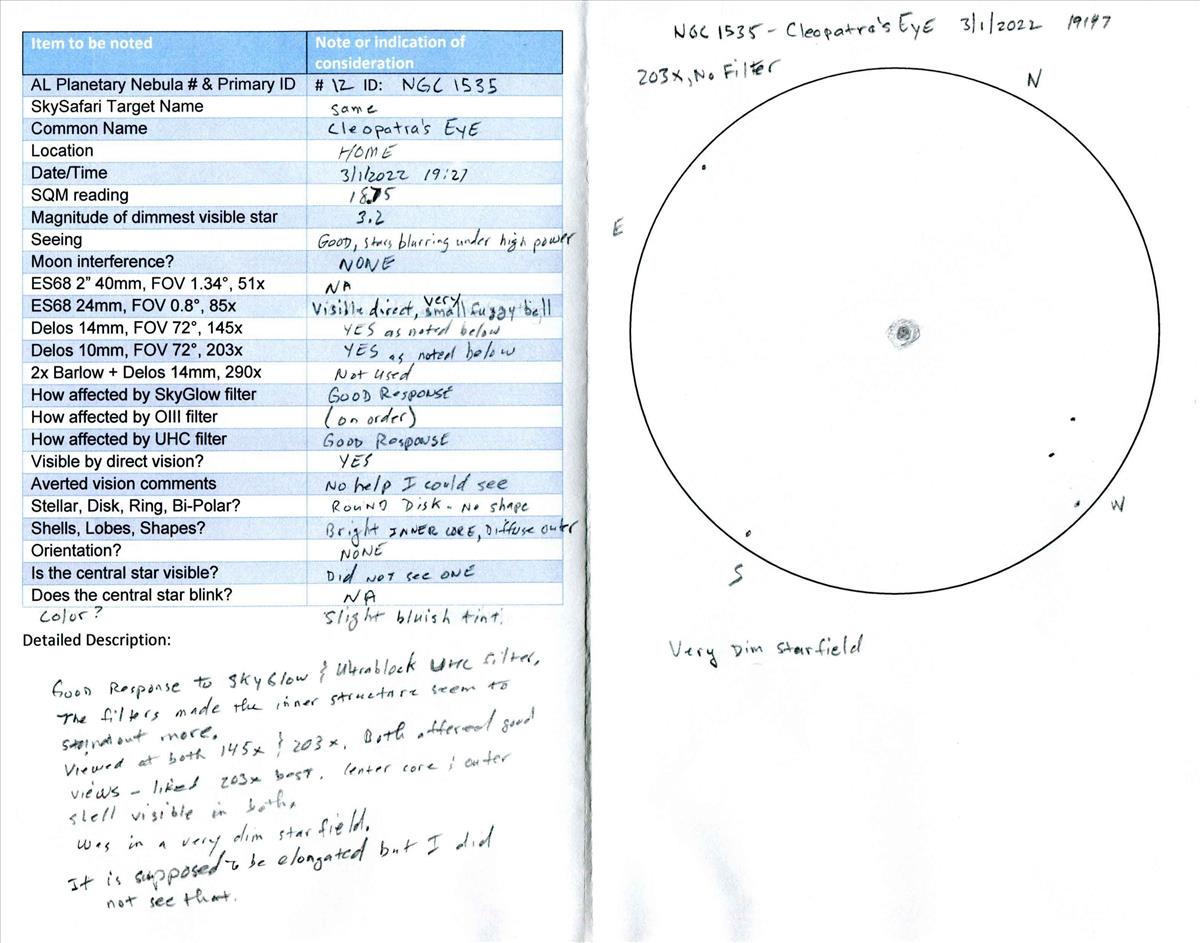
Good response to SkyGlow and Ultrablock filters which made the inner structure stand out more. Viewed at 145x and 203x both offered good views - liked the 203x view vest - inner core and outer shell visible in both. The nebula is supposed to be elongated but I did not see that. Did not observe any blinking effect. I did observe a slight bluish tint. Star field was very dim. This is an interesting nebula and I rate it a four star object that should be viewed again and again.
AL #15 (pg30) - IC 418 "Raspberry, Red Planetary, Spirograph"
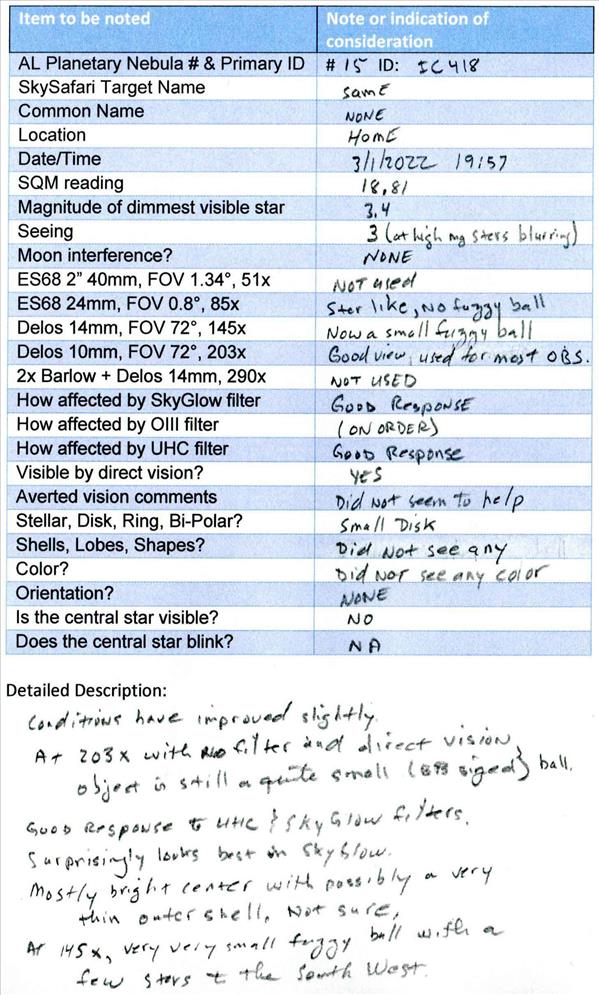
AL #15 (pg30) - IC418 - viewed 3/1/2022 19:57 A very small planetary object with no real details - just a small disk with no color. Possibly detected a thin outer shell - not sure. Good response to Ultrablock and SkyGlow filters (at this time did not have an OIII filter) - surprisingly looked best in SkyGlow. Since there was not much detail I did not sketch the object. I rate this as a two star object - visible but not interesting enough to keep revisiting.
AL #16 (pg31) - NGC 2022
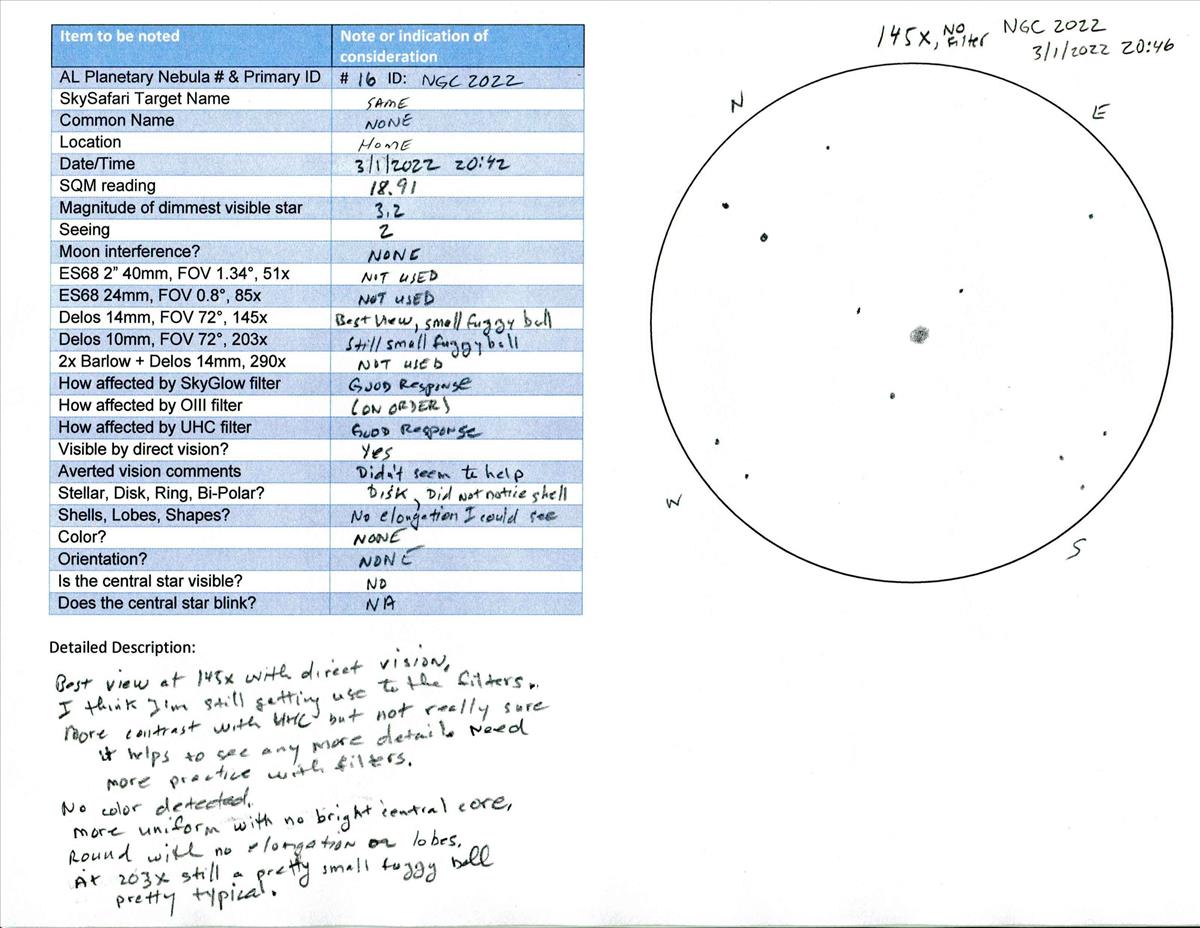
Best view at 145x with direct vision. More contrast with Ultrablock narrowband filter but not really sure it helps to see more detail. No color detected. Uniform disk with no shell or shape. At 203x still a small fuzzy white ball. I rate this a two star object. Not interesting enough to revisit that often.
AL #17 (pg31) - IC 2149

Object was in a very nice star field which really help to confirm the Planetary Nebula. At 85x was stellar and had good response to Ultrablock narrowband filter but EXCELLENT response to OIII filter. This was a surprise because I usually don't find the OIII filter that helpful with my limited 8" scope. No real response noted with SkyGlow filter. At 145x, was still a very very small fuzzy ball. At 203x, still a very small fuzzy fall. No orientation or shapes observed.
AL #18 (pg31) - IC 2165
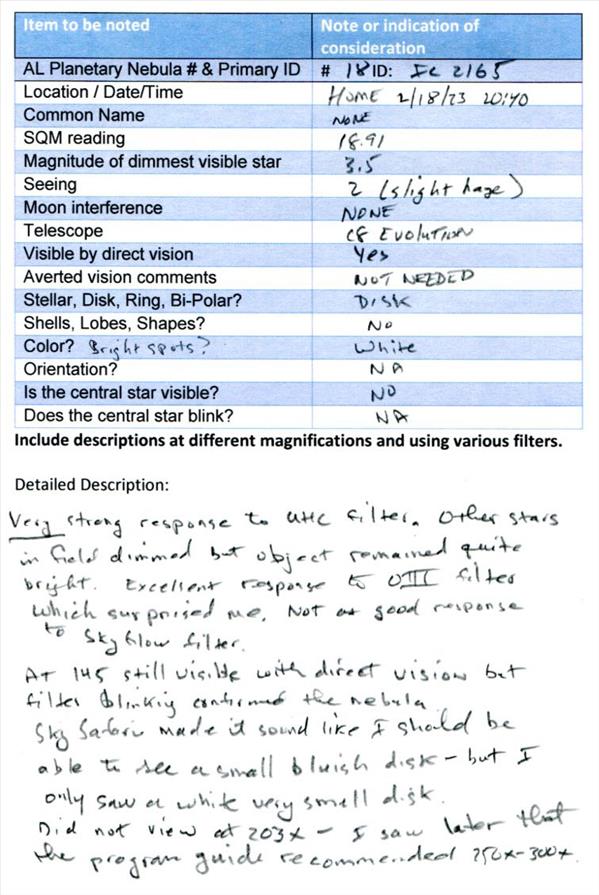
Very strong response to Ultrablock filter. Other stars in field dimmed but it remained bright. Stellar at 85x. Excellent response to OIII as well which surprised me. Not as good a response to SkyGlow filter. At 145x still visible direct but stellar. Again filter blinking confirmed this is a Planetary Nebula. SkySafari made it sound like I should be able to see a small bluish disk - but I only saw a very small bright white ball at 145x. Maybe I would have been able to seen the color at a darker site. Did not view this object at 203x - I saw later that the program guide recommended 250x to 300x.
AL #19 (pg32) - Jonckheere 900
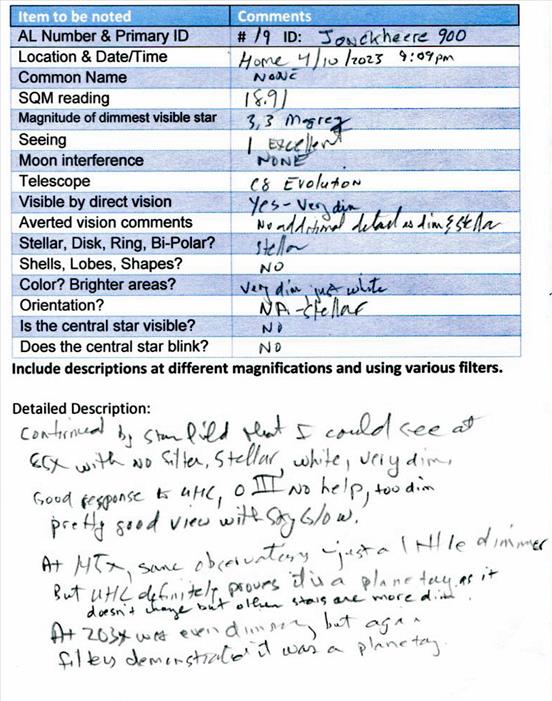
Confirmed by star field that I was looking at the planetary nebula. At 85x with no filter it was stellar, white and very dim. Good response to Ultrablock narrowband filter which confirmed I was looking at the nebula. OIII was no help since object was so dim. Pretty good with SkyGlow. At 145x, still stellar but noticably dimmer but again the Ultrablock narrowband filter confirmed I was looking at the PN. At 203x, PN was even more dim but filters again confirmed that I was looking at a PN.
AL #20 (pg32) - Minkowsk 1-7

I have tried probably more than 10 times before to see this PN with no luck. I kept trying because it was favorable for spring and was one of the few outstanding PNs in the program list I could see from home at this time. I was determined to make another strong effort to find the PN. I studied the star field where it was supposed to be and confirmed where I thought it should be but still could not see it. Then I tried with my Ultrablock Narrowband filter and there it was! At 85x with no filter I could not see the PN. But with the Ultrablock filter I could see it as a faint small disk to the south east of a brighter star (HD260556)! Yippee - finally success! As the object was pretty dim there was some doubt about this observation - but I was pretty confident. Appeared almost stellar at 85x, no shapes or rings or orientation. No color observed. Excellent response to Ultrablock Narrowband even with direct vision - slightly better with averted. Could not see with OIII as image is too dim - this is typical for my 8" scope with dim objects - the OIII filter is just too strong. Surprisingly, the SkyGlow filter added enough contrast that I could see the PN using averted vision. At 145x, definitely not stellar - a faint small disk best with Ultrablock Narrowband filter. Here is a Cloudy Nights post I submitted regarding the object Can Minkowski 1-7 be viewed with an 8 inch telescope
AL #21 (pg32) - NGC 2346 "Hourglass Nebula"
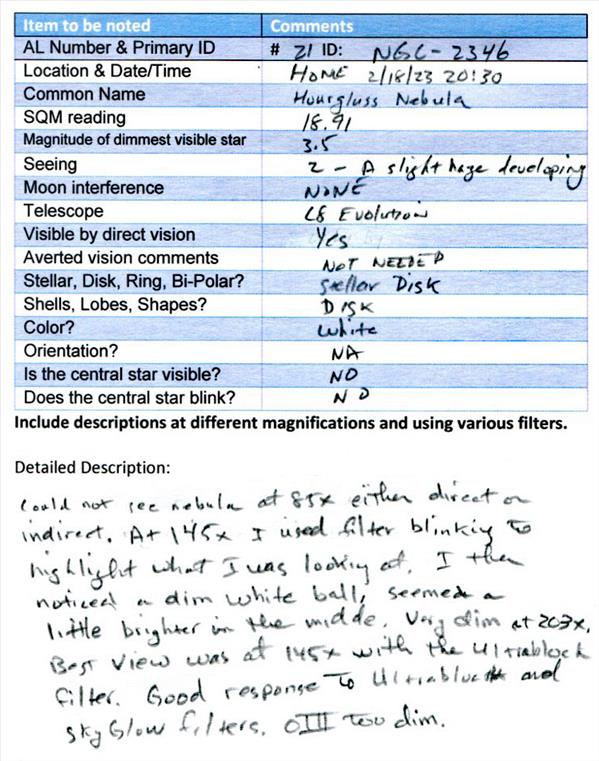
Could not see at 85x using direct or indirect vision. At 145x I had to use filter blinking by going back a few forth from no filter to the Ultrablock narrowband filter to see a very small white fuzzy ball. Brighter in the middle. Very dim in my 8 inch. At 203x very dim - best view was at 145x with the Ultrablock filter. Good response to Ultrablock and SkyGlow filters - OIII filter was too dim.
AL #22 (pg33) - NGC 2371-2 "Double Bubble"
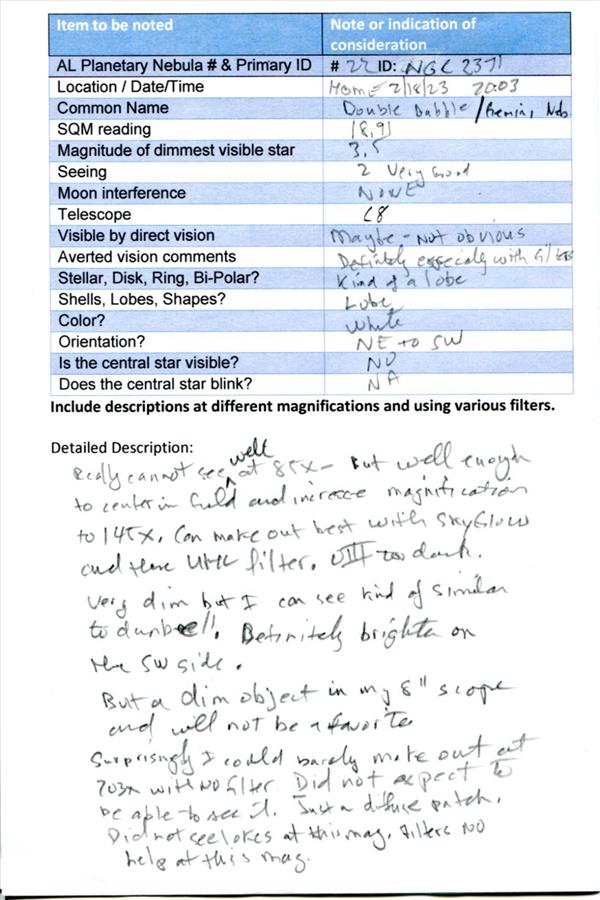
Could barely see at 85x with no filter and direct vision - but I could see a fuzzy" well enough to center in the field and increase magnification to 145x. The nebula looked best at with the SkyGlow filter followed by the Ultrablock narrowband filter. The OIII was too dim to be of use. At 145x with the SkyGlow filter and averted vision I could make a dim lobed object that looked a little like a dim dumbbell nebula. The object was oriented NE to SW with it being a little brighter on the SW side. At 203X I was surprised that I could see the object with direct vision with no filter but I could not detect the lobes that I thought I saw at 145x. Central star was not visible at any time. But the object is pretty dim in my 8" scope and will not be a favorite that I keep revisiting.
AL #24 (pg33) - NGC 2392 "Eskimo, Clown Face Nebula"
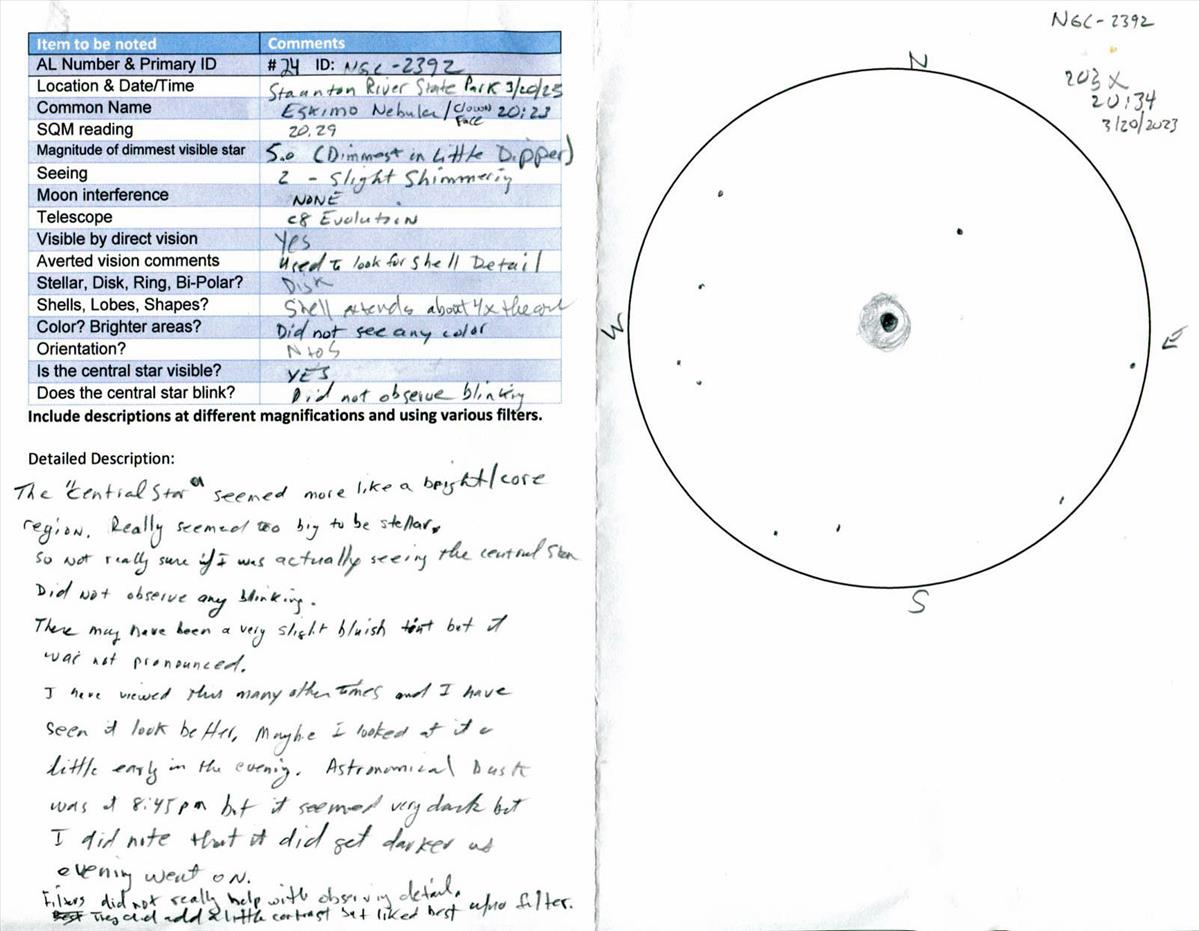
I have observed this object many times in the past and this was not one of the better views I've had of this object. I saw a bright core but it was not stellar and I did not see a central star within the core. It was interesting that the core did not seem to be centered - on the eastern edge the outer nebulosity seemed to fall off. I did not observe blinking which is not a surprise since the central star would be too dim to ovewhelm the nebula. I see blue better with my left eye and I did observe a slight bluish tint with my left eye. The object was pretty bright and I did not observe any additional detail using averted vision. The Ultrablock narrowband, OIII and SkyGlow filters all improved the contrast but really didn't add any detail. Preferred viewing with no filter. There was a shell and there seemed like there was a slight gap between the core and the outer edge but I'm not sure I would say this was annular.
AL #25 (pg34) - NGC 2438
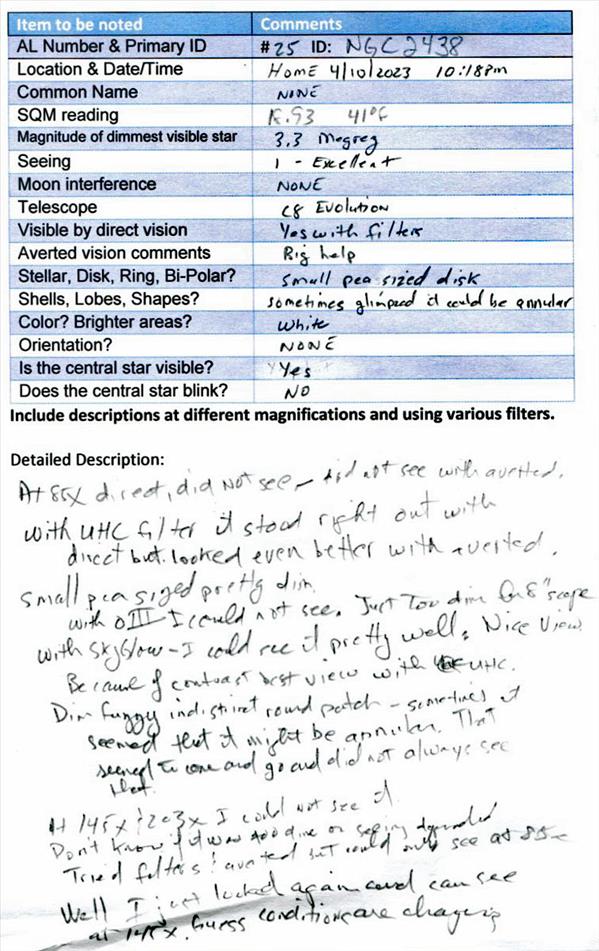
At 85x with no filters did not see using direct or averted vision. With the Ultrablock narrowband filter it stood right out with direct but looked even better with averted vision. Object appeared to be pea sized and was pretty dim. With the OIII filter I could not see - it was just too dim with my 8" scope. With SkyGlow I could still see it! Yet again, this filter is proving to be very versatile. Due to increased contrast best view was definitely with the Ultrablock filter. Object was a dim round patch - after observing for awhile it seemed that sometimes the object was annular - but it was fleeting. At 145x and 203x I could not see the object. Not sure why. Perhaps it was just too dim or that conditions degraded. I tried again a little later and I could see it at 145x. Maybe it was darker as evening progressed.
AL #26 (pg34) - NGC 2440
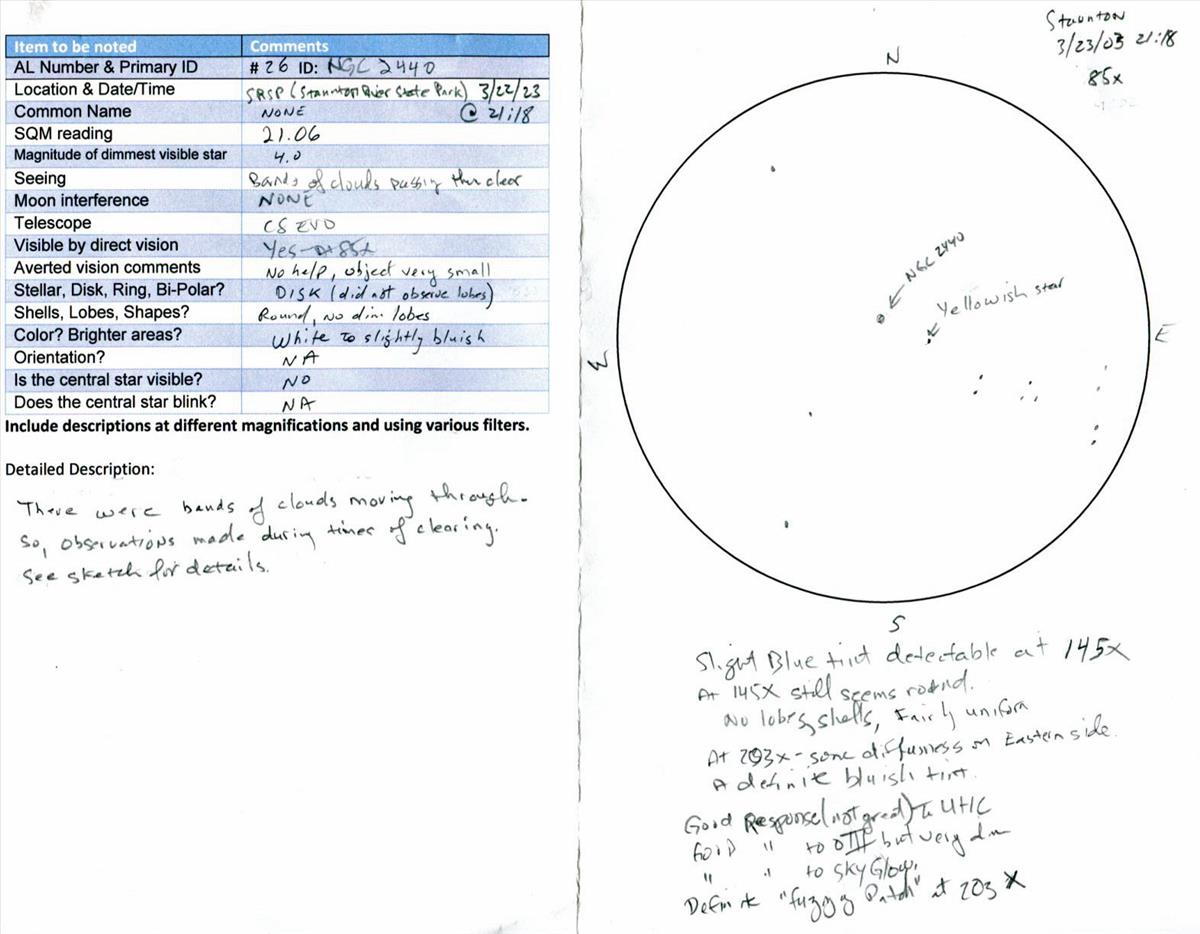
Slight blue tint detecable at 145x and seems round, no lobes or shells and appeared farily uniform. At 203x, saw a definite fuzzy patch with some diffuseness on the easter side and PN had a definite bluish tint. Good repsonse to Ultrablock UHC but not great. Good Response to OIII but very dim. Good response to SkyGlow with starfield still visible.
AL #33 (pg36) - NGC 3232 "Ghost of Jupiter"
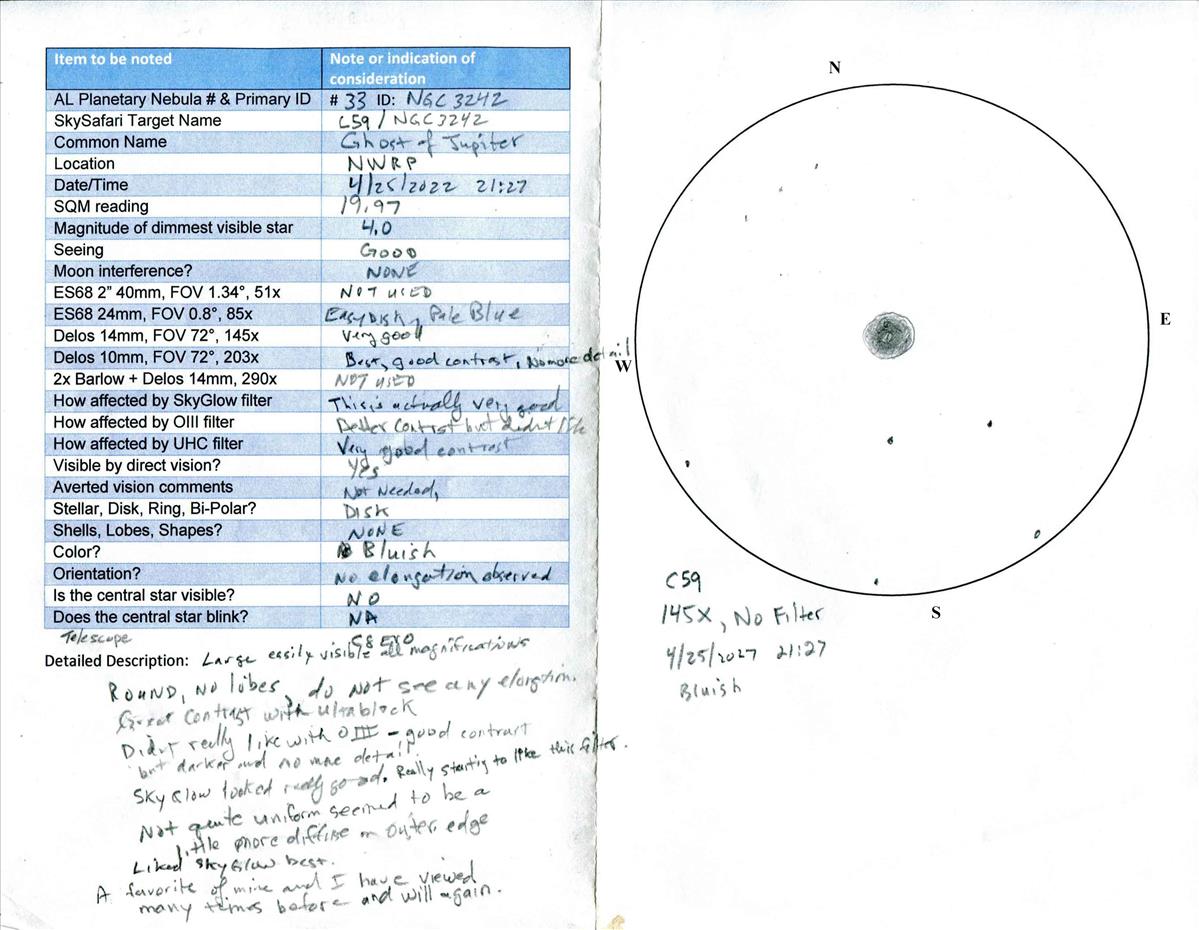
AL #33 NGC3242, C59, Ghost of Jupiter - viewed 04/25/2022 21:27 Large slightly bluish planetary nebulaeasily visible at 85x. Great sponse to Ultrablock narrowband filter with a nice increase in contrast but did not like with the OIII filter because it made the object too dim. Nebula looked really nice using the SkyGlow filter - that filter is doing suprisingly well with planetary nebulas because it increases contrast without dimming the object too much. Object was not uniform and seemed more diffuse as you moved away from the central core. No elongation, shapes or defined shells noted. Did not observe any blinking effect and did not see a central star. Viewed at 85x with more detail visible at 145x and 203x - liked the 203x view the best. I rate this a four star object to be revisited again and again.
AL #34 (pg37) - NGC 3587 "Owl Nebula"

At 85x not visible with direct or averted vision with no filter. I could make out the nebula with the Ultrablock narrowband filter AND the OIII filter. The SkyGlow filter did not help. I was a little surprised by the OIII filter's performace as for really dim objects it usually doesn't help much. At 145x I could make out some "cloudyness" that pretty much seemed to fill the view. It was very very suttle. Best at 85x with Ultrablock. The object was big enough that I didn't try any higher magnifications. Did not observe a central star. This observation was from home - I've seen this object look much nicer at darker sites but when using filters it's not bad from home!
AL #35 (pg37) - NGC 4361

Very dim and pretty low in a slightly hazy sky. Could see with no filter and the skyglow filer at 85x and 145x. Definitely see a very faint fuzzy patch. If I cup my hands around the eyepiece to block outoutside light I can see the central star and in fact I saw the nebula blink! Very surprised at this. I had Ron look through my scope and he saw the nebula and confirmed the blinking. At 145x I believe I saw a very slight north south elongation. With the ultrablock it was visible but a little dimmer; with the OIII filter I could not see the nebula at all. After looking at the nebula, Ron imaged it and sent me a screen shot of it.
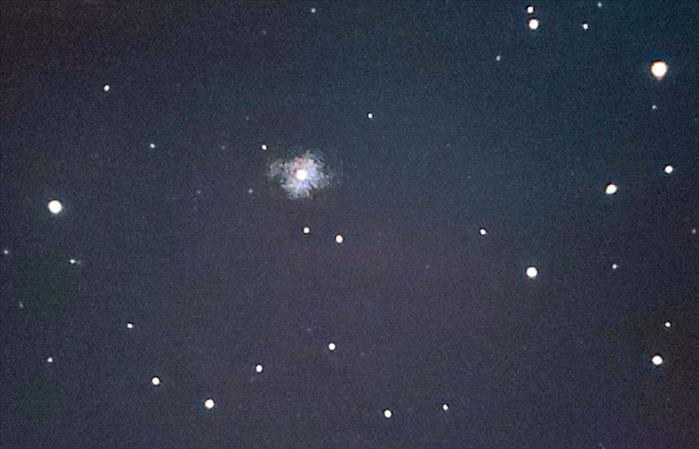
Afte we finished visually observing NGC-4361 Ron imaged the nebula and sent me a copy! I thought that was pretty cool. Photo by Ron Repinski
AL #36 (pg37) - IC 3568 "Baby Eskimo"
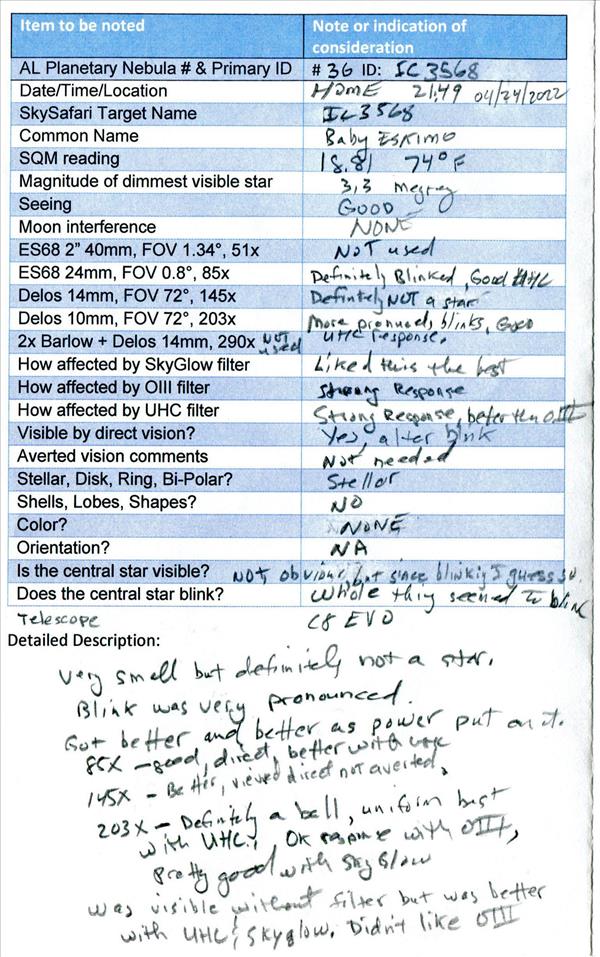
Very small but definitely not a star. Blink was very pronounced. The object got better as more power was put on it. 85x - Good, visible with direct vision but better with Ultralock narrowband filter. 145x - Better, viewed direct no improvement with averted. 203x - Definitely a uniform disk that was best with Ultrablock filter. Ok response with OIII and looked pretty good with SkyGlow. So all three filters improved this object. For this pretty bright object I preferred no filter.
AL #41 (pg39) - NGC 6058

Finally! This was a tough object! I spent a lot of time examining the star field to make sure I was looking in the right place. I tried 85x, 145x and 203x and my UCH Ultrablock, OIII and SkyGlow filters and could not see the nebula with direct vision. But, I could make out a faint fuzzy white patch using averted vision. Did not see the central star. Filters did not help at all. I called Shawn Loescher over to look and he confirmed that he could see the fuzzy with averted vision. Glad I could finally see this one. I had tried at least 4 times previously and was almost ready to give up.
AL #42 (pg39) - IC 4593 "White-Eyed Pea"
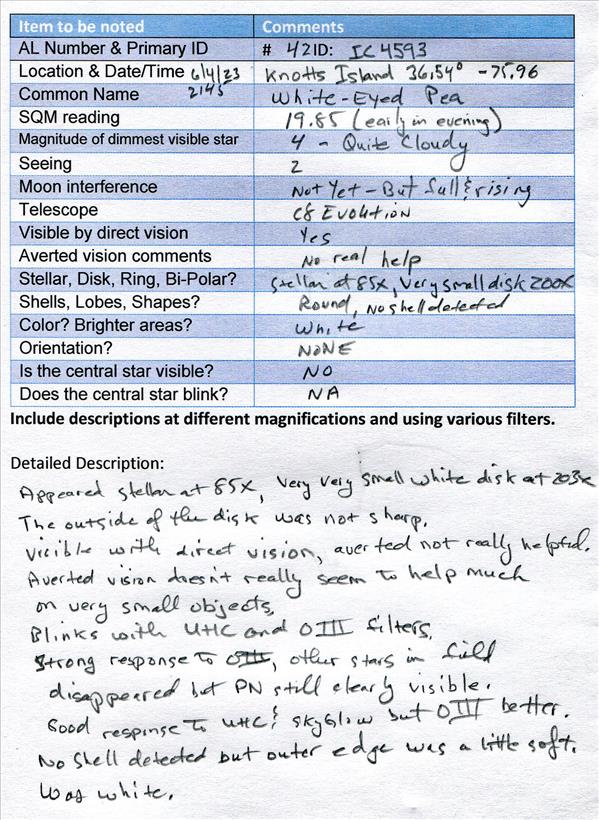
Appeared stellar at 85x. At 203x was a very very small white disk. Outside of disk was not crisp and sharp. See with direct vision. No color. Round. No orientation. Blinks with uhc and blinking even more pronounced with OIII. OIII dimmed all surrounding stars but nebula still visible. Averted vision did not seem to help much. I'm beginning to think that averted vision doesn't work well on very small almost stellar objects.
AL #45 (pg40) - NGC 6210 "Turtle Nebula"
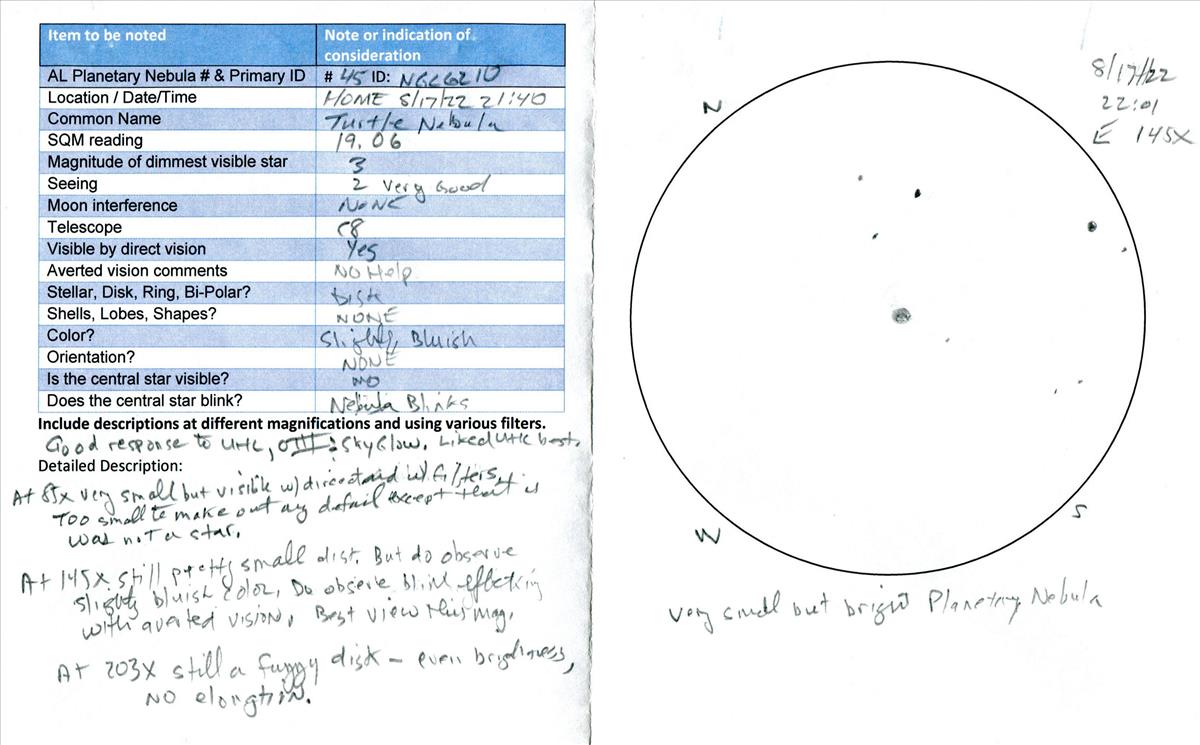
AL Planetary #45. NGC-6210 Turtle Nebula. 08/17/2022 22:01
| Visible with direct vision with good response to Ultrablock narrowband, OIII and SkyGlow filters. With indirect vision I observed the object to blink. In the AL program book blinking was not noted so I spent some time confirming that I did indeed observe the object to blink - it's what I observed. At 85x was very small but see that it was definitely not stellar. At 145x it was still a pretty small disk but could now observe a slightly bluish color and 145x was my preferred magnification for this object. At 203x still a fuzzy disk - even brightness - no core brightness or shell observed. Not sure why nebula was named Turtle" since there is no apparent shape. Summary: A small bright slightly bluish planetary nebula with no shape that blinks. Would rate 3 stars since mildly interesting and worth viewing again." |
AL #46 (pg41) - IC 4634
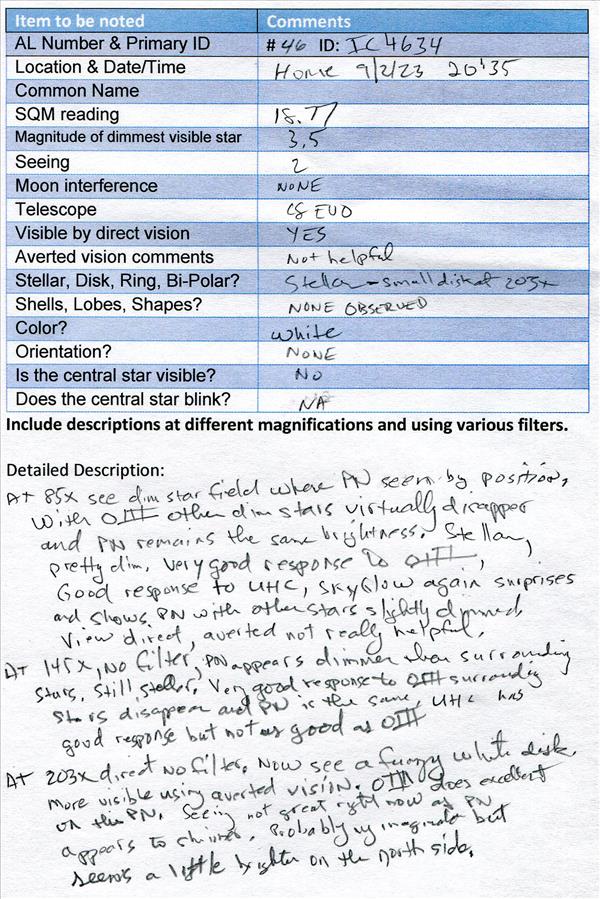
At 85x see a dim star field where I can locate the PN by star positions with direct vision. With OIII the other stars dim noticeably while the PN retained its brightness. PN is pretty dim and has good response to OIII and UHC filters. SkyGlow filter surprises yet again and shows the PN with some relative brightness (much less than OIII and UHC but still helpful). No changes with averted vision. At 145x with no filter, PN still stellar and appears dimmer that surrounding stars. With OIII PN surround stars dim and the PN retains its brightness so that the PN and surrounding stars seem to be about the same brightness. Same effect noted with UHC filter. At 203x, direct vision and no filter I now see a very small fuzzy white disk. The disk is more visible when using averted vision. Seeing appears to have worsened as PN seems to be shimmering. There seems to be a possible brightening of the PN on the north side.
AL #49 (pg42) - NGC 6309 "Box Nebula"
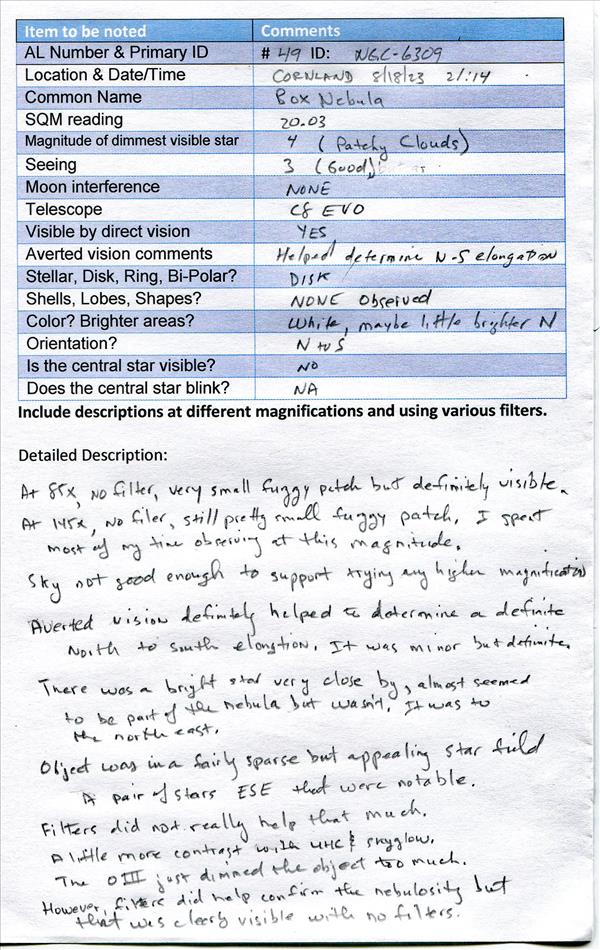
At 85x, no filter, could make out a very small white fuzzy patch that was definitely visible. At 145x, no filter, it was still a pretty small white patch. I spent most of my time observing at this magnitude. The sky wasn't good enough to support any higher magnification. Averted vision definitely helped to determine there was a N-S elongation of the nebula. There was a bright star to the NE of the nebula that "almost" seemed to be part of the nebula it was that close. Filters did not really help that much. With the UCH and SkyGlow the stars dimmed but the nebula stayed about the same brightness. The OIII filter was too strong, you could still the nebula but it was pretty faint, the surrounding stars totally disappeared. I would have made a sketch of the object but I was distracted by going back and forth to Sandy's telescope that I decided I wouldn't be able to concentrate enough to do a good sketch. For a dim 11.5 magnitude planetary - this wasn't bad.
AL #51 (pg42) - NGC 6369 "Little Ghost"
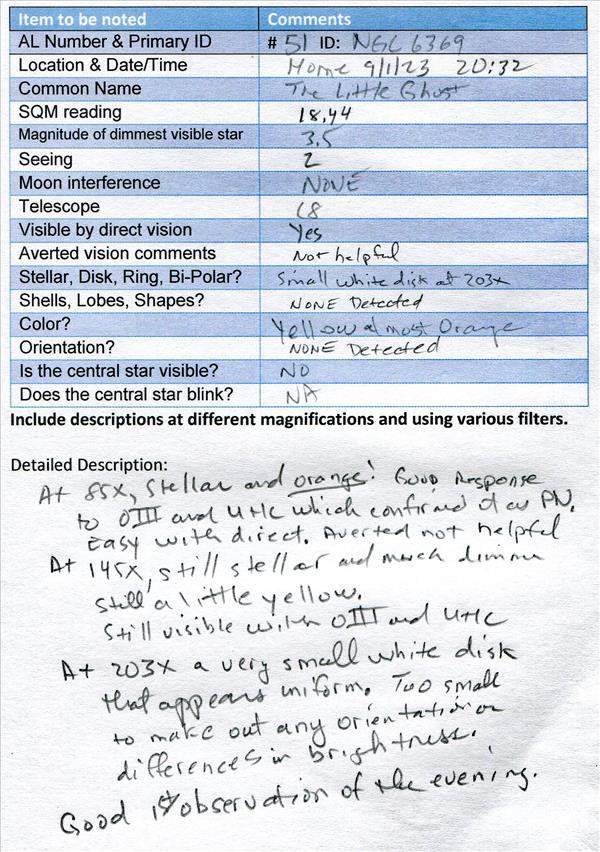
At 85x was stellar and yellowish-orange! This was interesting because, except for SkySafari's representation, nowhere else did I see this color described. That made me suspicious but good response to OIII and UHC and confirming star fields and other comments below confirmed it as a PN. Perhaps sky conditions gave it this color? think this is the first PN I have observed that appeared yellowish. Easy with direct vision and averted didn't really help. At 145x, it was still stellar but dimmer but still slightly yellowish. Still visible with OIII and UHC filters when other stars in field are dimmed. At 203x I could see a very small white disk that appeared uniform. Program guide and DSS picture showed some annularity but I could not make any since it was still very small at 203x. I did not observe any orientation or differences in brightness. This was a good first PN observation of the session.
AL #52 (pg43) - NGC 6445 "Little Gem"

| At 85x can see with direct vision as a large fuzzy patch. Strong response to Ultrablock narrowband filter. Too dim for OIII but looked pretty good with SkyGlow - best with Ultrablock. No color observed - it just looked white. There appears to be two lobes that are not connected. At 145x a little more contrast but still not a lot of detail. The Ultrablock filter seemed to emphasize the bright lobes but resulted in loss of the tenuous of the nebula. It is better without the filter. The dimmer lobe stood out more when using averted vision. The star field was fairly sparse - I didn't see nearly as many stars as shown in the program photo or the DSS image. I don't think my eyes were that dark adapted to pick up the dimmer stars. Didn't like at 203x - too dim. In summary, a fuzzy patch with what seemed like two lobes where the southern lobe was brighter and larger than the northern lobe which really only stood out with averted vision. This is at odds with the AL program book which said the northern lobe looked brighter. But, that was not what I observed. I rate this as a three star object worth viewing again. |
AL #54 (pg43) - NGC6543 "Cat's Eye Nebula"
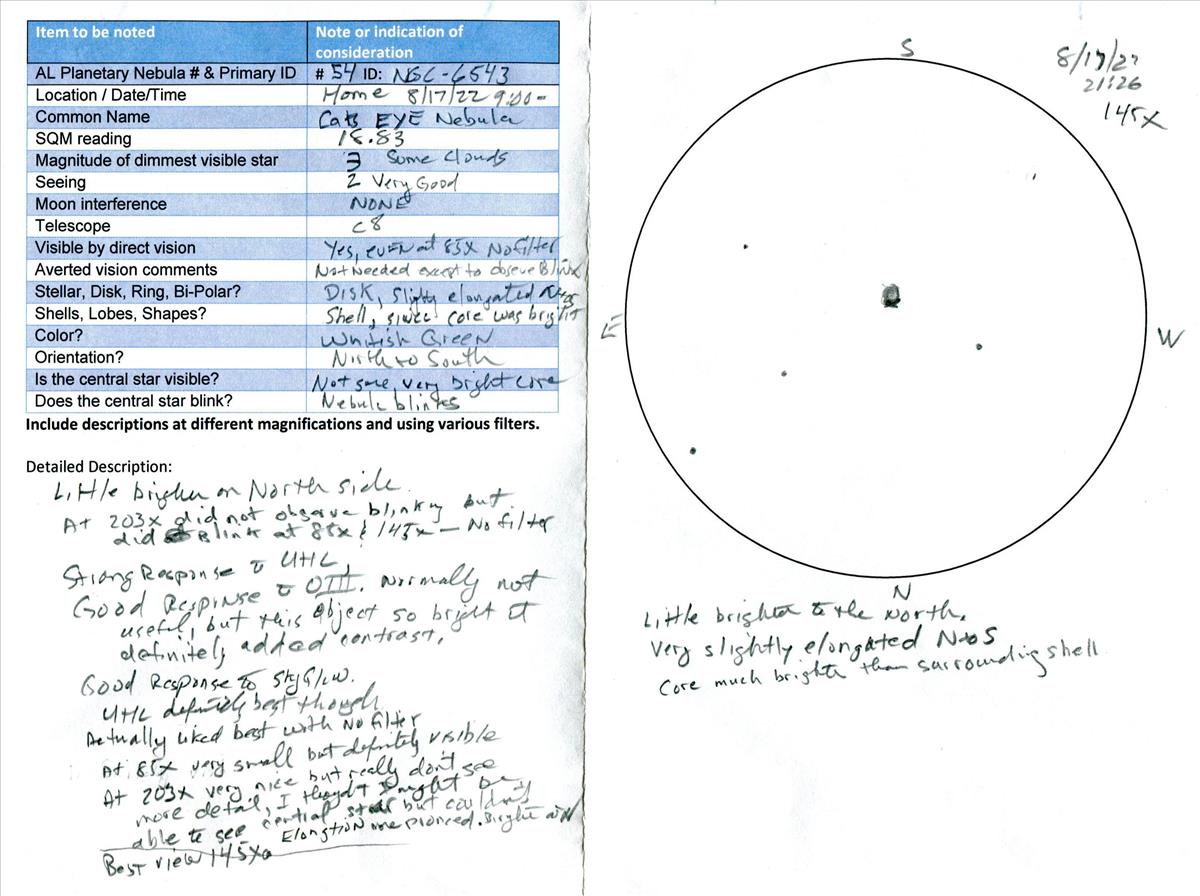
AL Planetary object #54. MGC6543 (Caldwell 6) Cat's Eye Nebula - viewed 08/17/2022 21:26
| This was the 4th time I observed this but first time for AL Planetary program. Observed object for 30 minutes - 15 minutes of which was to make a sketch. Object visible with direct vision. Using averted vision nebula was observed to blink. Did not observe a standout central star. Object was whiteish green. Good response to Ultrablock narrowband, OIII and SkyGlow filters. Best in Ultrablock but I actually preferred no filter. Usually the OIII filter is too dim but this was a bright object and the OIII did provide some good contrast but was the least pleasing of all the filters. A disk brighter at center but not extremely so. Slightly elongated north to south. Seemed a little brighter on the north side. Very small at 85x but definitely a disk. Best at 145x with ability to see some slight elongation and a slight difference in brightness. 203x was dimmer and didn't offer any improvements in detail. Summary: A small but bright planetary nebula with not much detail visible. I rate this a three star object that is worth revisiting but is not great. |
AL #55 (pg44) - NGC 6537 "Red Spider Nebula"
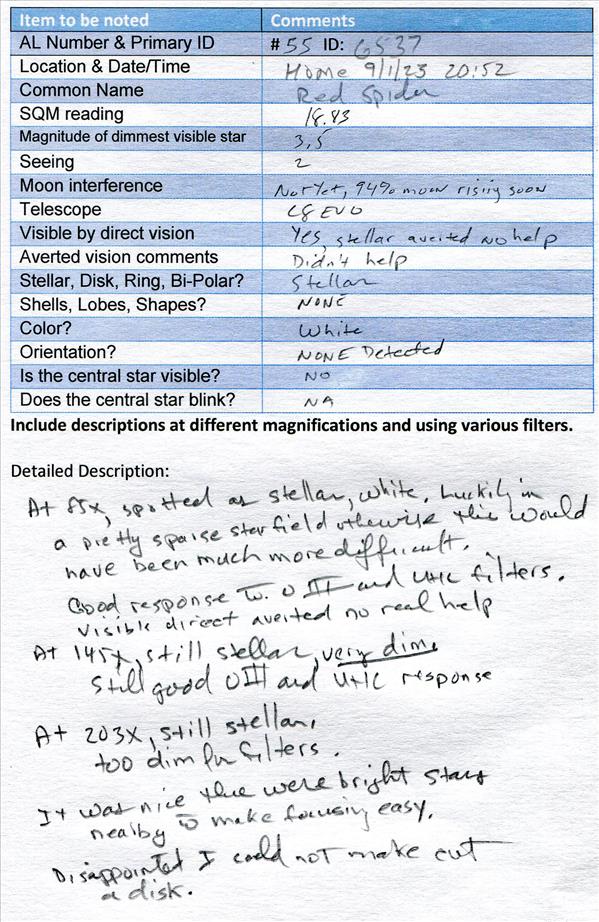
At 85x, spotted as stellar and white. Luckily in a pretty sparse star field otherwise this PN would have been much more difficult. Good response to OIII and UHC filters. Visible direct, averted no real help. At 145x, still stellar and very dim. Still good OIII and UCH response. At 203x, it was too dim for filters to help in my 8 inch scope still visible direct and averted but could still only see as stellar. It was nice there were some relatively bright stars in the field to help with focusing. I was disappointed that I could not make out any disk and object only appeared as stellar.
AL #58 (pg45) - NGC 6572 "Blue Racquetball"
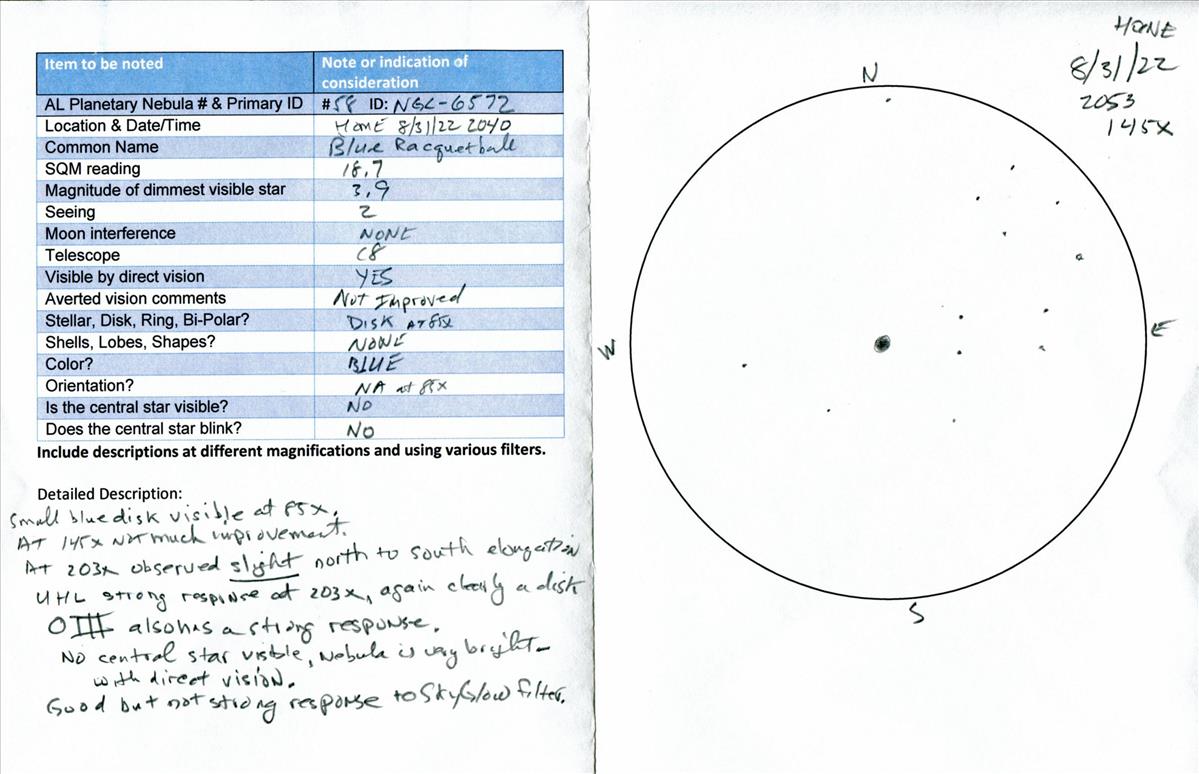
AL Planetary Nebula Program #58. NGC 6572 Blue Racquetball Nebula. First object viewed tonight so probably not completely dark yet. Small blue disk at 85x. Not much change at 145x. At 203x observed "slight" North to South elongation. Central star not observed. Strong response to Ultrablock narrowband, OIII and SkyGlow filters. Pretty bright with direct vision - no additional details noted using averted vision. Does not blink. Rate this object 2 stars - visible but not interesting enough to revisit.
AL #59 (pg45) - NGC 6567
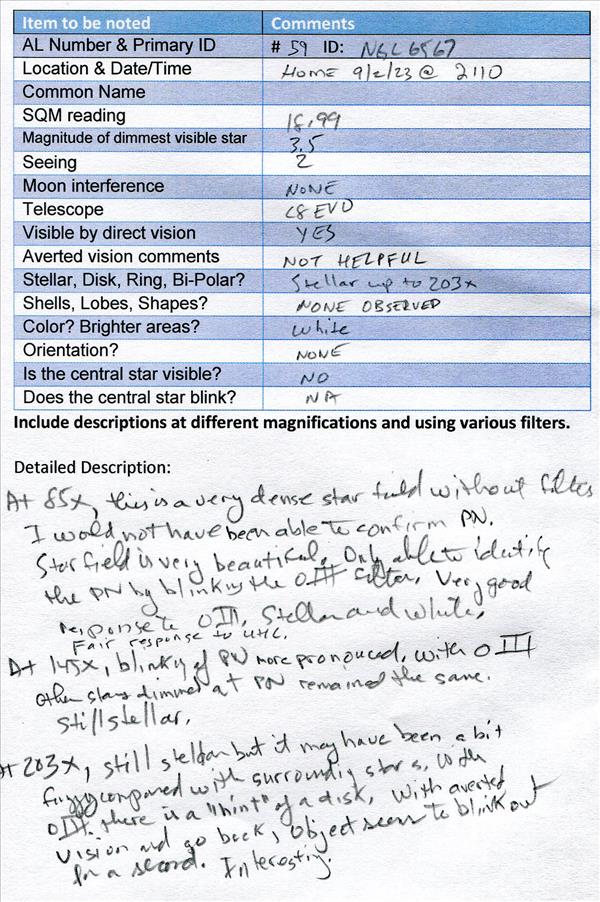
At 85x, the PN is in a very dense star field - quite pretty but makes it very difficult to find the PN. Without filters I would not have been able to confirm I was looking at the PN. Blinking with an OIII filter showed me the PN as the other stars faded and the PN stayed the same. Very good response to OIII, fair response to UHC. Stellar and white. At 145x, the PN is even more pronounced when blinking with OIII filter. Still stellar. At 203x, still stellar but there may have been a hint of fuzziness to the PN - surrounding stars looked pinpoint but PN was slightly fuzzy. With averted vision there was a hint of a disk. When going back and forth between averted and direct vision the PN seemed to blink which really surprised me! I repeated the exercise several times and it was pretty consistent. The program guide didn't mention that the object blinked and I'm skeptical but that's what I observed.
AL #62 (pg46) - NGC 6629
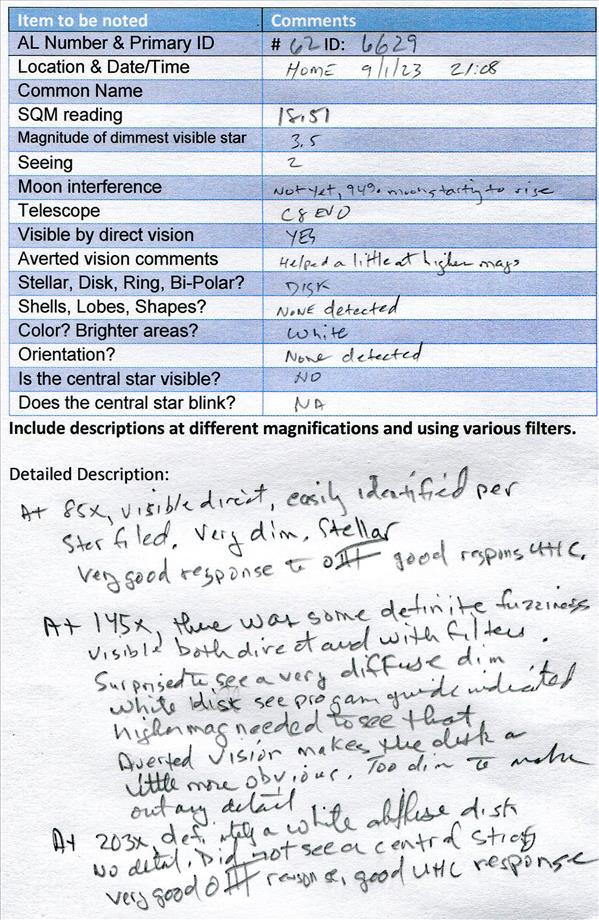
At 85x, very dim and was stellar but easily visible with direct vision. I confirmed that I was looking at it via the star field. Very good response to OIII and good response to UHC. I am starting to appreciate the OIII filter more when looking for PNs that are almost stellar. At 145x, there was some definitely some fuzziness visible with direct vision with and without filters. I was surprised to see a very dim, diffuse white disk as the program guide indicated I would need higher magnification to detect that. Spent quite a bit of time confirming that I did see a ghostly disk at this magnification. Object too dim to make out any details other that a small white fuzzy disk. No orientation or shape detected. At 203x, definitely see a small dim white diffuse disk. Did not see a central star. Very good response to OIII and good response to UHC. This was the darkest sky of the observing session as a 94% moon was starting to rise. After this SQL meter showed sky was getting brighter.
AL #63 (pg46) - NGC 6644

The PN was just above the teapot and at 85x it is dimmer than the surrounding stars. With OIII the PN seemed to brighten to be about the same brightness as the surrounding stars. There was a definite change in the relative brightness that confirmed I was looking at the PN. Good response to OIII and milder response to UHC. PN is white and stellar. At 145x, still stellar and white with good OIII and UHC filter responses. At 203x, I might be seeing a very very small white disk. The surrounding stars are still pinpoint where the PN appears a smidgen larger than pinpoint. PN definitely best when viewed though OIII filter.
AL #66 (pg47) - NGC6720 "Ring Nebula"

AL #66 - NGC6720 - M57 Ring Nebula - viewed 6/24/22 at 23:30 I have viewed this object many many times - it is a favorite of mine. The ring is clearly visible at 85x - but did not notice any central nebulosity At 145x inner nebulosity noticed - slightly greenish color. Best view. Good response to UCH and SkyGlow filters but too dim for OIII filter to help - preferred no filter.
AL #70 (pg49) - NGC 6741 "Phantom Streak"

At 85x, used a pair of two bright stars to the SSE to center the view on where I thought the PN should be located. View was a field of very dim stars none of which stood out as the PN. With UHC filter all of the dim stars disappeared except for one which must be the PN which was in the center of the view. That was pretty satisfying since the PN was obvious and I didn't have to spend much time confirming it. The PN is pinpoint stellar and white. Averted vision didn't show any additional detail. With the OIII the PN was barely visible but none of the surrounding stars were visible at all. The PN was visible with the SkyGlow with the surrounding stars barely visible. The SkyGlow filter continues to impress. At 145x no filter, the star field was even dimmer that at 85x. With UHC Ultrablock the PN was still clearly visible and the surrounding stars have faded from view. Again with the OIII the PN was barely visible but the surrounding stars were not visible at all. At 203x, PN was still stellar with the same filter comments as above. Averted vision revealed no additional detail.
AL #71 (pg49) - NGC 6751 "Dandelion Puff Ball"

At 85x I could not find it even using filters and averted vision. When I was sure I was looking in the right place I upped magnification to 145x and tried again. At 145x could still not see without using filters either direct or averted vision. But when I viewed using the OIII filter the PN "popped" into view even though it was still very dim. It was a very "ghostly" dim white disk. Averted helped a little but it was still quite dim, dimmer than I expected. Not as good with UHC filter but still visible. Surprisingly it was visible with SkyGlow which gave a pretty good view when using averted vision. I did not see a central star. At 203x, I could still make out a very dim smudge using NO filter with averted vision. With OIII and UHC filters object was too dim for me to see it. Could still see it with SkyGlow! Moon was just starting to rise and SQM reading was starting to drop. I tried to view some other PNs but I could tell the moon was starting to wash everything out (even M31!) and I called it a night. I was disappointed with this PN as I expected to be able to see it better.
AL #75 (pg50) - NGC 6778

After centering view on where I thought the PN should be I could not find the PN even using filters and averted vision. The star field was just too busy to be sure. At 145x, I could see a very faint white smudge below a line of stars that were running SE to NW. With UHC the smudge was still very very faint but the additional contrast made it stand out better. Averted vision definitely helped to see the smudge as a faint disk. With the OIII filter the PN was too faint and I did not see it even with averted vision. At 203x, I could see the smudge with direct and averted vision with no filter! This is a PN where magnification really helps. Very dim with the UHC Ultrablock. The smudge was too faint for the Orion OIII filter for me to see it even with averted vision. I spent quite a bit of time on this PN trying to see if I could make out any detail on the smudge but it was so faint it was pretty difficult. There were times of seeing that I thought I could make out the smudge as being oblong with an east to west orientation but I couldn't consistently make that out. This was a pretty difficult PN.
AL #76 (pg51) - NGC 6781 "Snowglobe Nebula"
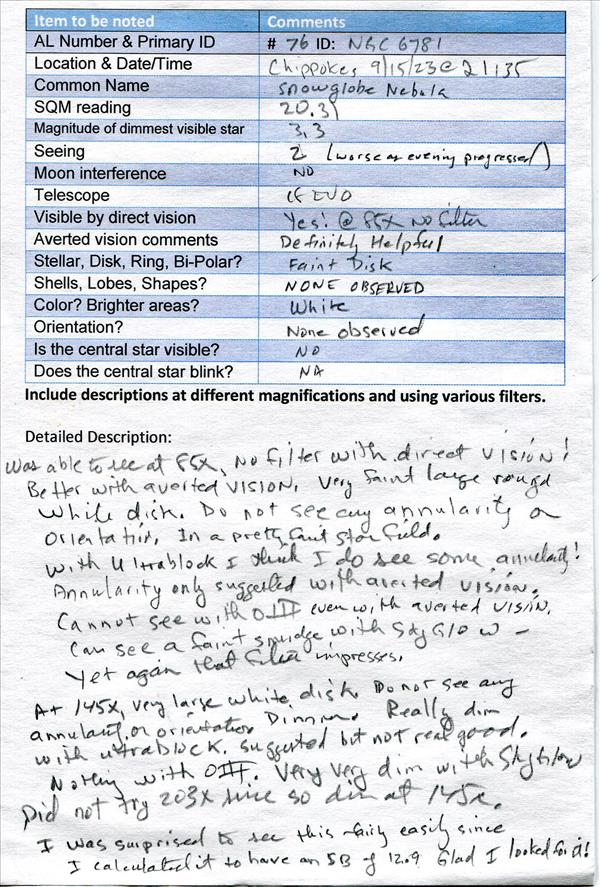
Was able to see at 85x using no filter and direct vision! It was better with averted vision. Very faint large round white disk. Do not see any annularity or elongation. In a pretty star field. With Ultrablock I do see some 'suggested' annularity using averted vision. Cannot see with OIII even with averted vision. Could see a faint smudge with SkyGlow - yet again that filter impresses. At 145x PN appear as a dimmer larger white disk and I'm not seeing any annularity or elongation. With Ultrablock still detectable with averted vision but it is really dim. With OIII do not see it at all. It was very very dim with SkyGlow. I did not try 203x since it was so dim at 145x. I was surprised to see this PN so easily since I calculated it to have a SB of 12.9 which is close to the limit of what I can usually see. Glad I looked for this one it was a delight when it popped into view like it did. Looking through the eyepiece and seeing something that you didn't expect is always a thrill.
AL #77 (pg51) - NGC 6790
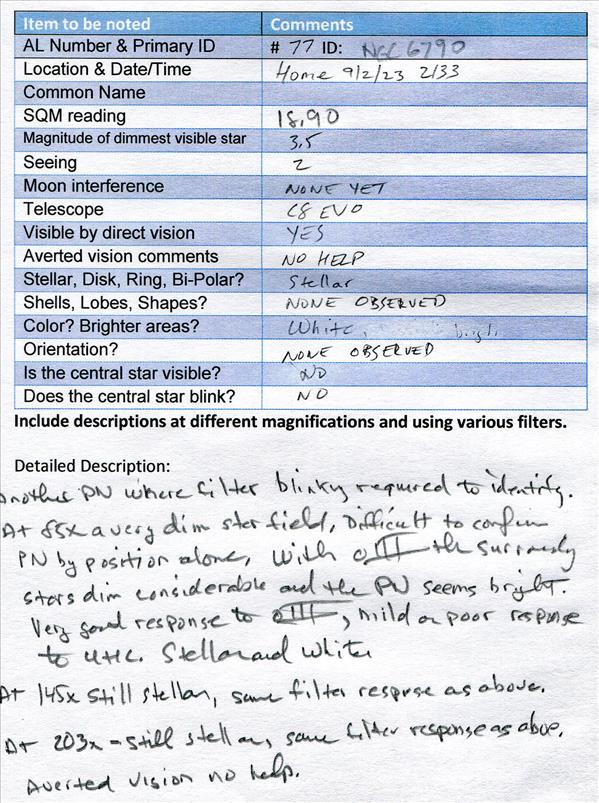
Another PN where filters required to identify. At 85x, a dim star field, could not confirm the PN by starfield positions alone. With OIII the surrounding stars dimmed considerably and the PN now seems brighter than the surround stars. Very good response to OIII and a milder or poor response to UHC. PN is stellar and white. At 145x still stellar, same filter response as above. At 203x, still stellar, same filter responses, averted vision no help.
AL #79 (pg52) - NGC 6803
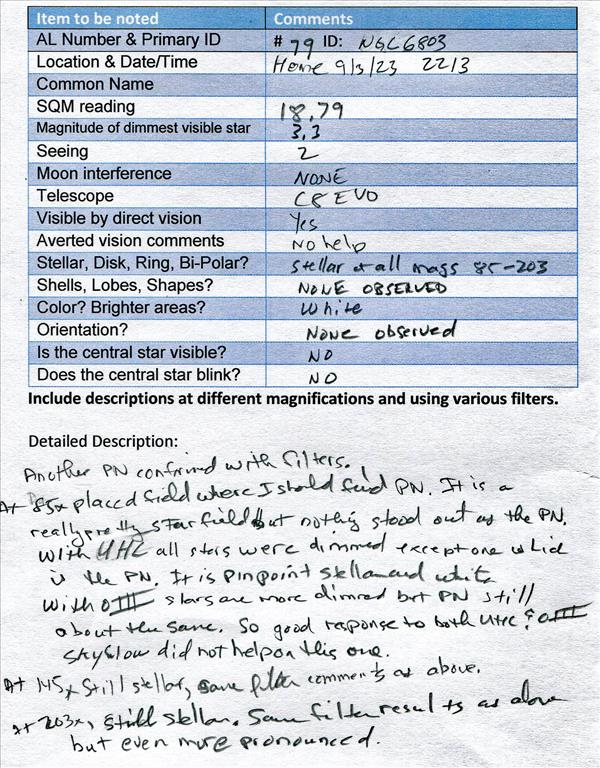
At 85x placed field where I should find the PN. View is a really pretty star field but nothing stands out as the PN. With UHC filter all stars were dimmed except one which is the PN. It is pin point stellar and white. With OIII stars are dimmed even more but PN remained the same brightness again confirming it as the PN. So good response to both UHC and OIII. At 145x, still stellar. Same comments as at 85x - averted vision did not reveal any additional detail. At 203x, still stellar and white. Same filter comments as at 85x but relative brightness differences even more pronounced. Averted vision did not reveal any additional detail.
AL #80 (pg52) - NGC 6804

At 85x I can see PN with averted vision and hints of it with direct vision. Definitely better with averted vision. It is very small but visible with no filter. In a very nice star field. With UHC surrounding stars are dimmed but the PN is still visible. I could make out some N to S elongation. With OIII was still visible but more dim than with UHC. With SkyGlow only visible with averted vision. At 145x with no filter only visible using averted vision. With UHC and OIII the PN was too dim to see even using averted vision. Surprisingly I was able to see PN with averted vision using the SkyGlow broadband filter. In fact the orientation was even more detectable and now appear to be NE to SW. At 203x was visible with no filter using averted vision. With UHC and OIII not visible with direct or averted vision. I could still see it with SkyGlow using averted vision. This PN was best viewed with no filter. I was concentrating so much on trying to make out any details of the PN that I did not notice if the central star was visible.
AL #83 (pg53) - NGC 6818 "Little Gem Nebula"
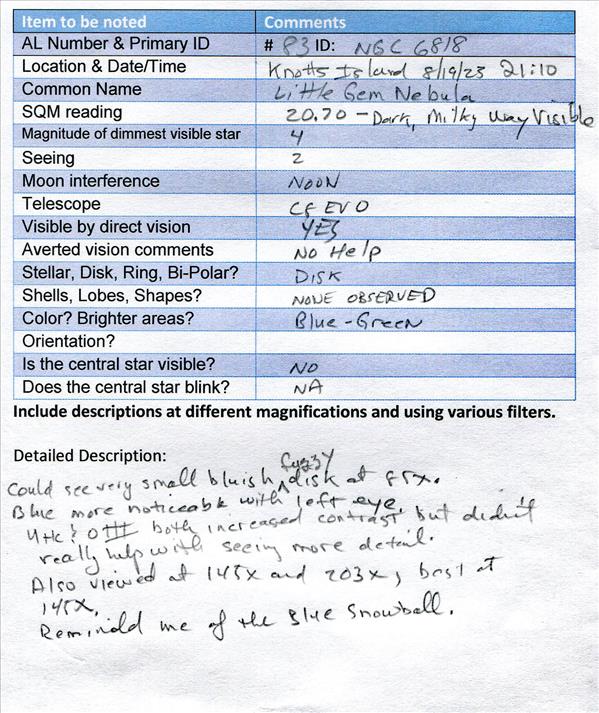
Very small bluish "fuzzy" disk at 85x. Blue was more noticable with left eye. UHC and OIII both increased contrast but really didn't help with seeing more detail. Also viewed at 145x and 203x. Best view was no filter at 145x. I did not note the elongatoin or hole that the program guide referenced. Other than a disk, no shape or elongation noted. This object reminded me of the blue snowball planetary nebula.
AL #84 (pg53) - NGC 6826 "Blinking Planetary"
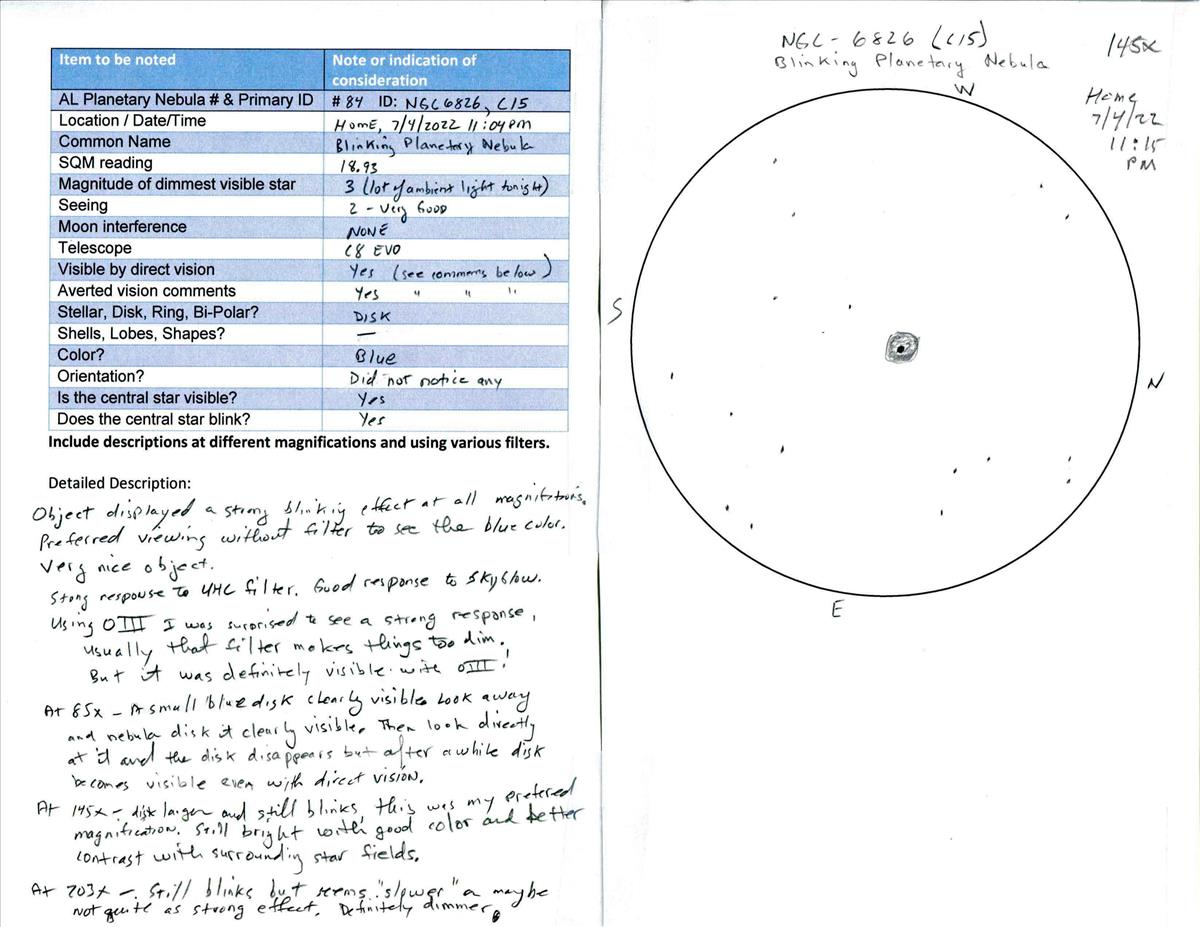
Object displayed a strong blinking effect at 85x, 145x and 203x. Preferred viewing is without filter to see the blue color. This is a favorite object that I often show at reach to demonstrate the blinking effect. Strong response to Ultrablock filter and a good response to the SkyGlow filter. Using the OIII filter I was surprised to see a strong response, usually the filter makes things too dim but it was definitely still visible with the OIII. At 85x - a small blue disk clearly visible. Look away (i.e. use averted vision) and the nebula disk is clearly visble Look back to view directly and the nebula disk disappears for a few seconds as the central star overwhelms the nebula. At 145x - disk is large and still blinks and still bright with good blue color and good contrast with the surrounding star filed. My preferred view. At 203x - still blinks but seems "slower" so maybe the effect is not quite as strong. The object is definitely dimmer at this magnification.
AL #86 (pg54) - NGC 6853 (M27) "Dumbbell, Applecore Nebula"
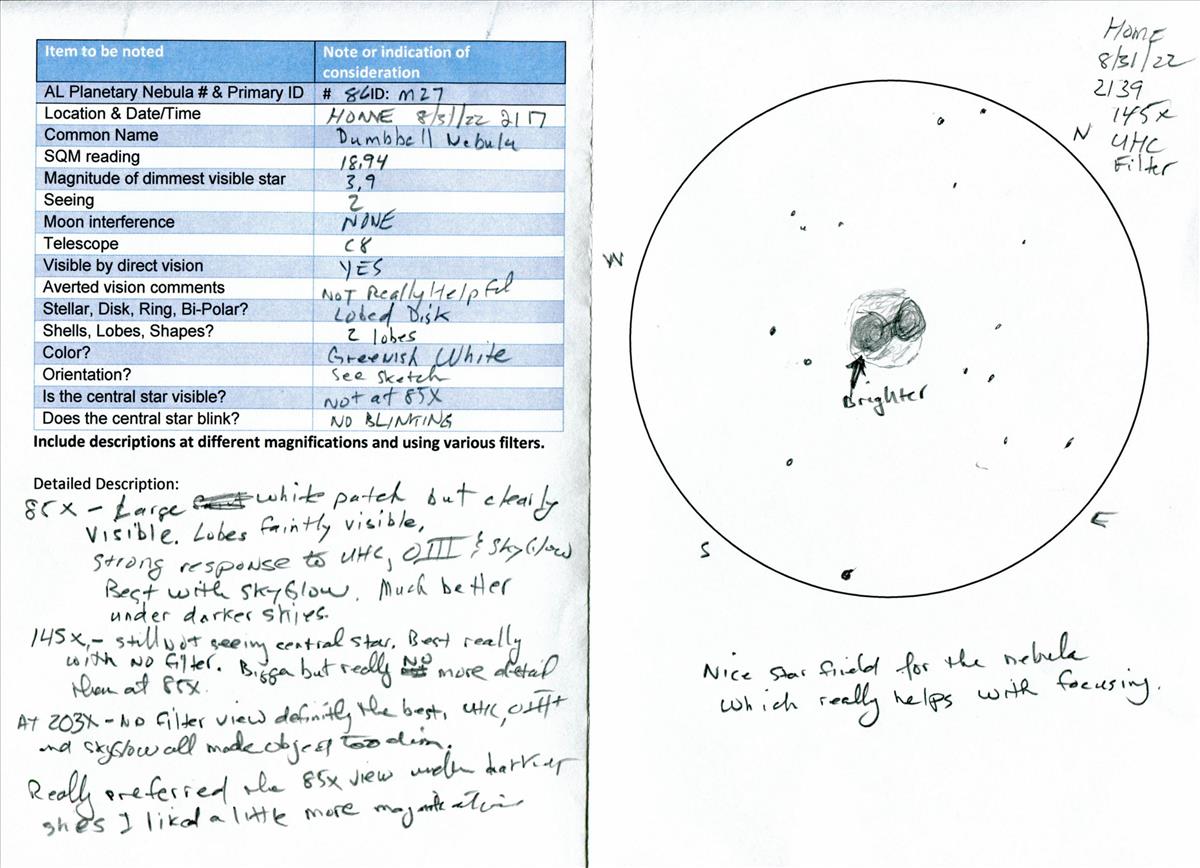
AL Planetary Nebula Program #86. NGC 6853 (M27) Dumbbell or Applecore nebula. I've looked at this nebula many times. Tonight it is not as well defined as I sometimes see it. At 85x easily located as a large circular "lobed" white patch. Did not note any color tonight - sometimes is looks a little greenish. Did not see the central star. At 85x NE to SW lobes were faintly visible with the SW lobe being slighter brighter than the NE lobe. (The AL Planetary Nebula guide says the NNE lobe is brighter, but it didn't look that way to me). Strong response to Ultrablock, OIII and SkyGlow filters but the OIII filter dimmed the object too much to be really useful. At 145x the view is really nice - still not as much contrast as I usually see it but still very good tonight. Even though filters provide more contrast it looked better with no filters. At 203x object really too dim to spend much time at this magnification. This is one of my 4 star objects and I almost always show it at outreach events.
AL #87 (pg54) - NGC 6884
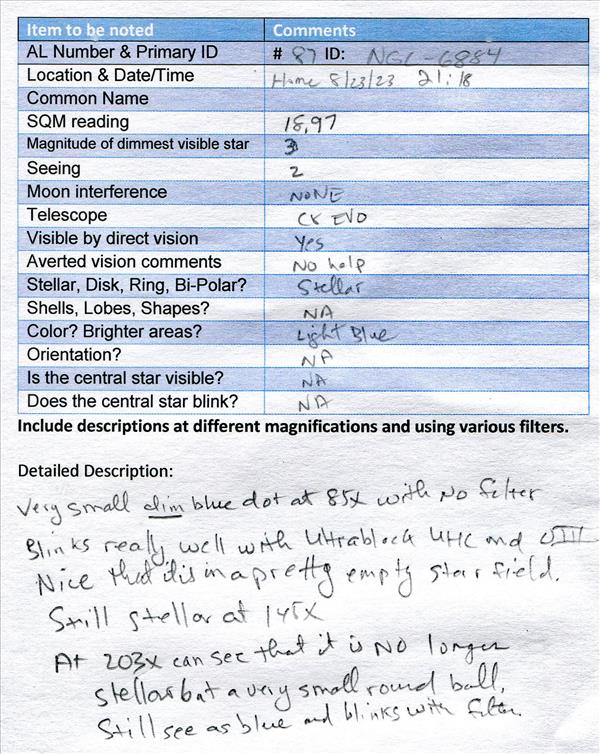
At 85x very small dim blue dot with no filter. Blinks really well with Ultrablock and OIII filter. Pretty easy to spot this one since was in a pretty empty star field. Still stellar at 145x. At 203x can see that it is no longer stellar but a very small round blue ball that blinks well with Ultrablock and OIII filters. Did not see a central star.
AL #90 (pg55) - NGC 6886
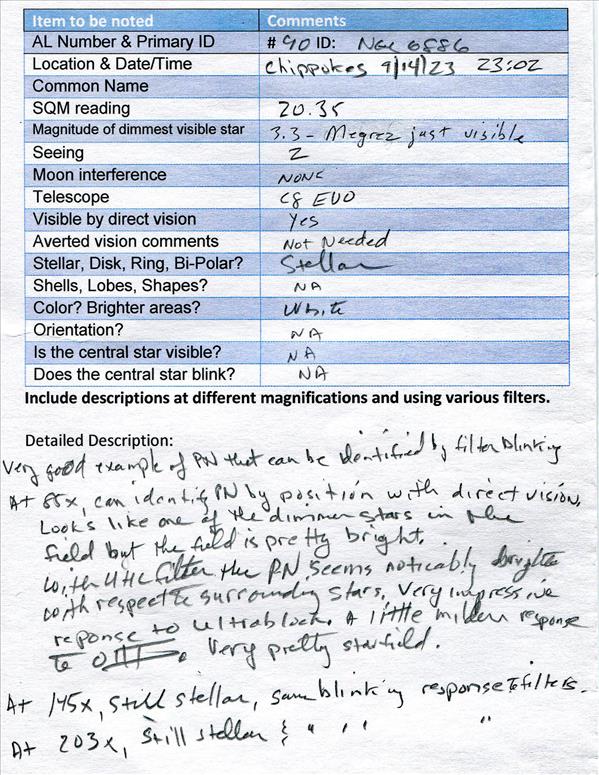
Very good example of a PN that can be identified by filter blinking. At 85x I identified the PN by position with direct vision where it looked white and stellar and like one of the dimmer stars in the star field. Other stars in the star field were brighter. With the Ultrablock UHC filter the other stars in the field were dimmed and the PN seemed noticeably brighter as compared to the other stars. Very impressive response to UHC a little milder response to the OIII. This was a very pretty star field. At 145x, still stellar with same filter responses. At 203x, still stellar with same filter responses.
AL #91 (pg56) - NGC 6891
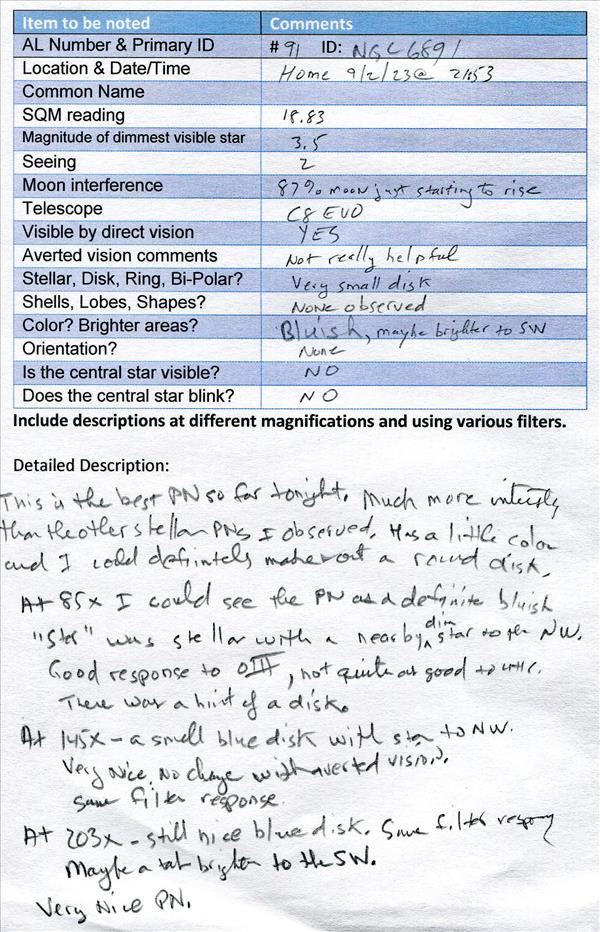
This is the best PN of the night so far. Much more interesting than the other stellar/almost stellar PNs observed earlier. This PN is noticeably bluish and has a distinctly small round disk. At 85x I could see the PN as a bluish star with a nice dim companion star to the NW. Good response to OIII, not quite as good to UHC. There was a 'hint' of a disk if looking really hard - but pretty much stellar. At 145x it was a small blue disk with a nice star to the NW. Very pretty view. No change with averted vision. Same filter responses as above. At 203x it was still a nice blue - which I thought was unusual since at higher mags I usually note a loss in color. There seemed to be a possible brightening to the SW - not really sure. This was a very nice PN which I really enjoyed.
AL #92 (pg56) - NGC 6894
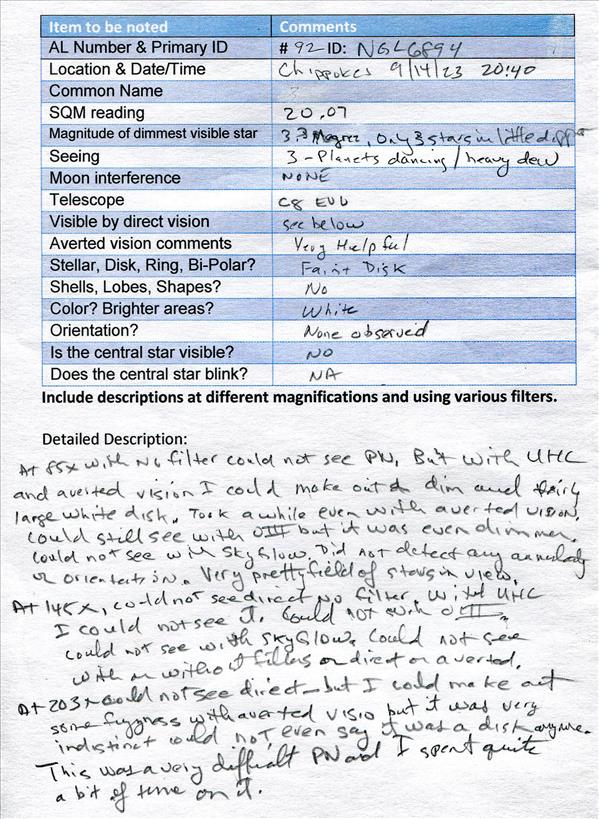
At 85x no filter I could not make out PN. But with Ultrablock UHC and averted vision I could make out a very dim fairly large white disk. It took awhile to see the disk even with averted vision but after awhile it seemed to stand out. With OIII it was still visible with averted vision but was more dim than when using UHC filter. Could not see at all with SkyGlow filter. Did not detect any annularity or orientation or areas of brightness. Very pretty field of stars in this view. At 145x with no filter I could not see with direct or indirect vision. When viewed with the Utrablock, UHC and SkyGlow filters I could not see the PN with either direct or indirect vision. At 203x I could not see the PN with direct vision but thought I detected some fuzziness using averted vision. Was very indistinct - not sure I could even say it appeared as a disk anymore - more of any irregular blob. This was a very difficult PN and required me to spend quite a bit of time and effort on it to see what I was able to make out.
AL #93 (pg56) - IC 4997
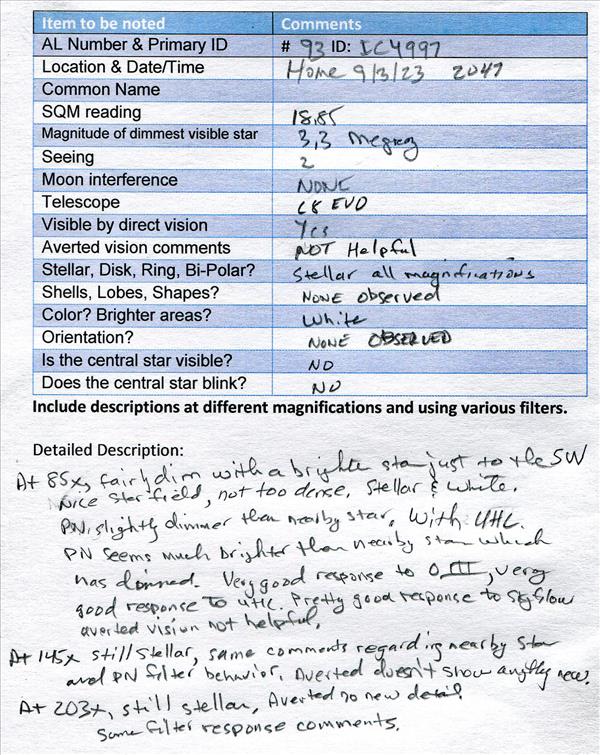
At 85x PN was fairly dim with a brighter star to the SW. A very nice starfield, not too dense so that I could pick out the PN by position. The PN was stellar and white and slightly dimmer than the nearby star. With the UHC Ultrablock the PN now seems brighter the nearby star which has been dimmed. Very good response to both the UHC and OIII filters. At 145x, still stellar, same comments above regarding nearby star and filter behavior. Averted vision not helpful. At 203x, still stellar, averted vision offered no additional detail. Same filter comments as above.
AL #94 (pg57) - NGC 6905 "Blue Flash Nebula"

AL Planetary Nebula Program #94. NGC 6905 Blue Flash Nebula. Difficult to spot at 85x but I did see a faint fuzzy spot that was not stellar with direct vision. Much easier to spot at 145x - using averted vision definitely made it stand out more. At this magnifcation definitely noticed a N-S elongation. Ultrablock narrowband filter definitely helped to increase contrast. Strong response to Ultrablock, OIII and SkyGlow filters - looked best in the Ultrablock. Very dim at 203x - I "think" I could still barely see the nebula even using averted vision. OIII filter was too dim at this magnification. Best at 145x. Rate this object 2 stars - visible but not interesting enough to revisit.
AL #95 (pg57) - NGC 7008 "Fetus Nebula"
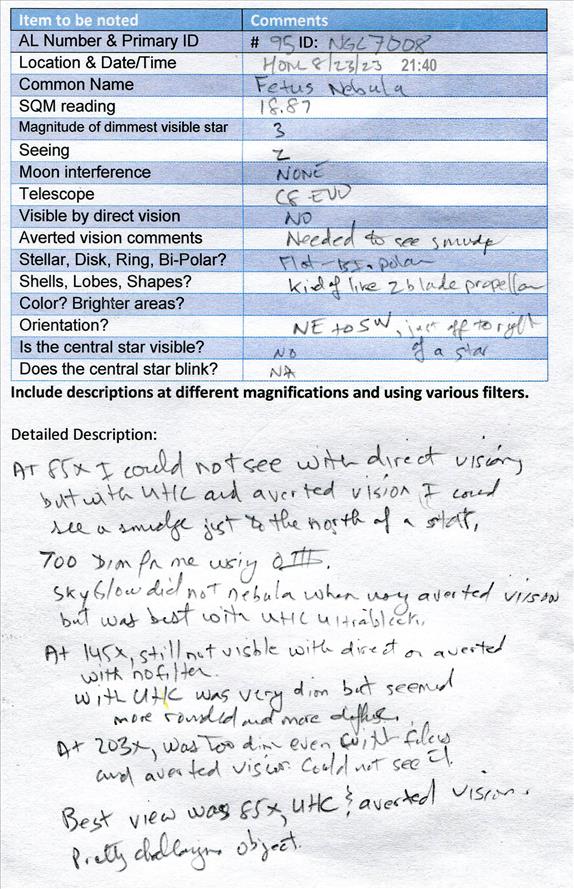
I could not see the PN with direct vision but I could with the UHC using averted vision. I could see a smudge just to the north of close by star. It was too dim for me using the OIII filter. Not visible with SkyGlow using direct or averted. At 145x, still not visible with direct or averted with no filter. With UHC was very dim but seemed more round and diffuse. At 203x, was too dim even with filters and averted vision I could not see the PN. Best view was 85x, UHC filter and averted vision. This was a pretty difficult object.
AL #96 (pg57) - NGC 7009 "Saturn Nebula"
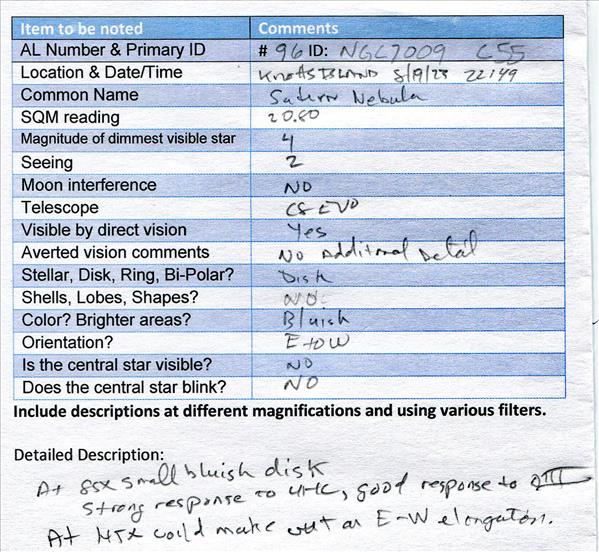
At 85x was a small bluish disk. At 145x could make out a slight E to W elongation. Strong reponse to Ultrablock UHC filter and good response to Orion OIII filter. This is a favorite object of mine and I have viewed it many times before. This was not the best view of thei object I've seen but it was a good view.
AL #97 (pg58) - NGC 7026 "Cheeseburger, Tiny Dumbbell

At 85x the view is dominated by the bright yellow star f2 Cyg. I see a star that is close to the PN to the south of the nebula but I do not see the nebula itself with direct vision. With averted vision I can make out the nebula as a very dim small white fuzzy ball. With UHC filter I can see the PN with direct vision and it even brighter(!) than the star to the south. Quite a surprise! The view is about the same with the OIII (i.e. strong response). The SkyGlow did not show the PN with direct vision but did improve the averted vision view. At 145x, I can see the PN with averted vision with no filter but I still cannot make out any detail - it is just too dim for my eyes to see any structure. The PN is more dim with the OIII than it was with the UHC but it still visible with direct vision. The PN is also visible with direct vision with the SkyGlow but UHC does a better job. At 203x, can see the PN as a dim, white, round smudge. Averted vision improves what I can see a little bit. It appears that the PN is a little brighter on the SE edge. The PN still looks better with averted vision using the UHC filter and is better than with the OIII.
AL #98 (pg58) - NGC 7027 "Geen Rectangle, Magic Carpet

Small bluish disk at easily seen 145x with direct vision. With left eye it did seem more greenish but I wouldn't say it was distinctly green. The disk was not crisp and seemed a little fuzzy. UHC and OIII did not dim the nebula but did not improve it either. I liked it best with no filter. At 203x ther might have been a slight elongation from NW to SE - but it was very slight. View was most pleasant at 145x where object was in a nice bright starfield and was bluish and round.
AL #102 (pg59) - IC 5117
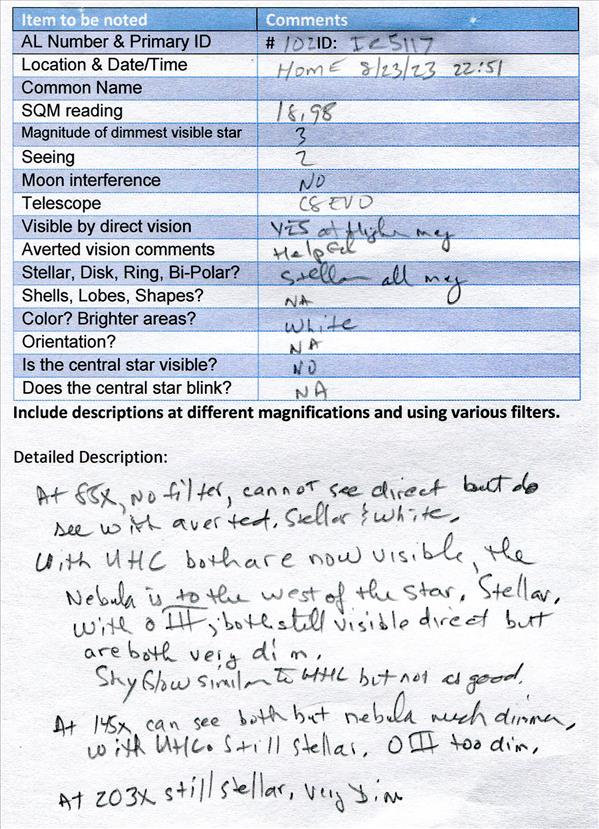
At 85x, no filter, cannot see with direct vision but I do see the nebula with averted vision as stellar and white. The nebula is to the west of the star. With UHC both the star and the nebula are visible with direct vision. With OIII both are still visible with direct vision but are much dimmer. SkyGlow filter shows view much the same as UHC just not quite as good. At 145x, can see both with direct vision but the nebula is much dimmer than the star. With the UHC the star and the nebula seem to be the same brightness. The OIII dims both too much. At 203x the nebula is still stellar and is very dim.
AL #103 (pg60) - Humason 1-2 "Baby Dumbbell"
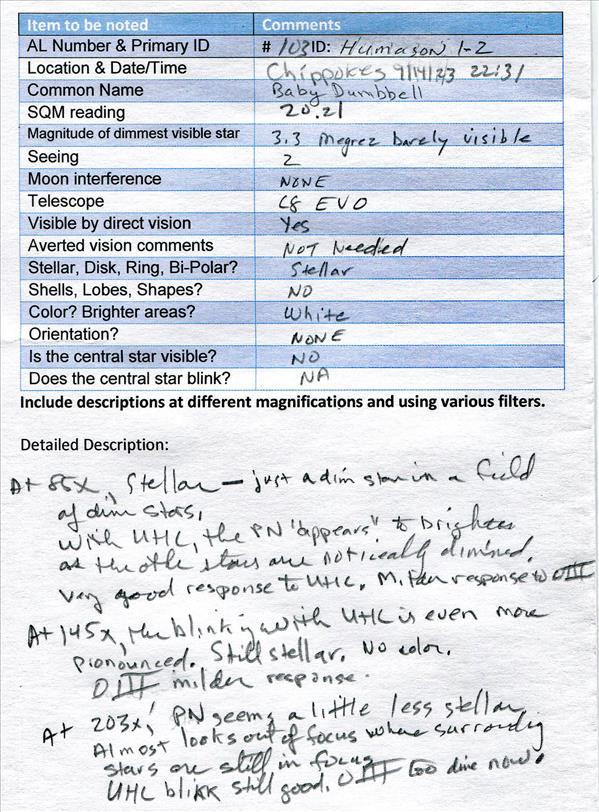
At 85x was stellar and white and dim in a field of dim stars. Was able to confirm it was a PN by using Ultrablock UHC where the other stars in the field dimmed and the PN remained the same brightness. Very good response to UHC and good response to OIII. At 145x the blinking with UHC filter is even more pronounced - still stellar and white. OIII response seemed a little milder. At 203x the PN seemed a little less stellar. It almost looked out of focus where the surrounding stars were still in pinpoint focus. Filter blinking with UHC still good. The OIII filter was too strong at this magnification as all the stars (including the PN) were no longer visible.
AL #105 (pg60) - IC 5217
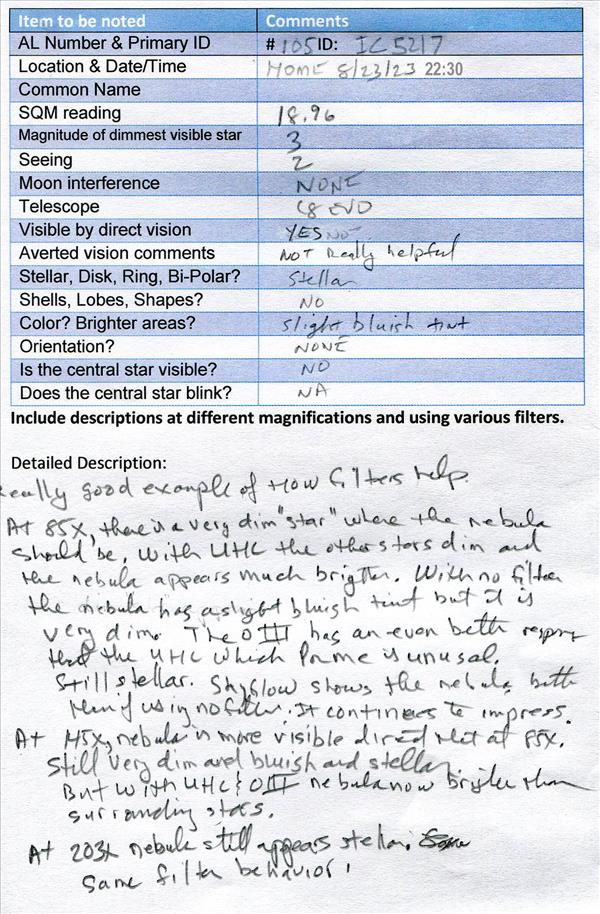
The PN is a really good example of how filters help. At 85x there is a very dim star" where the nebula should be found. With UHC the other stars dim and the nebula appears much brighter. With no filter the nebula has a slight bluish tint but it is very dim. The nebula had an even better response to the OIII filter which surprised me. The SkyGlow filter shows the nebula better than using no filter - it continues to impress me. At 145x the PN is more visible direct that it was at 85x but it is still very dim bluish and stellar. With UHC and OIII filters the PN now appears brighter than the surrounding stars. At 203x the PN still appears stellar with the same filter behavior as at 145x. A very interesting PN.
AL #106 (pg61) - NGC 7293 "Helix or Helical" Nebula
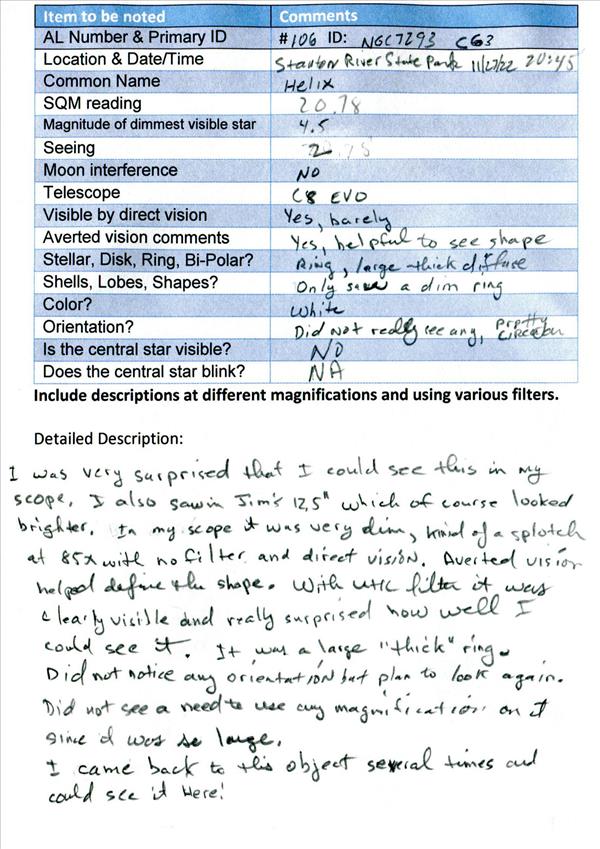
I was very surprised that I could see this in my scope. I also looked at it in Jim's 12.5" where of course it looked much brighter. In my scope it was pretty dim and kind of splotchy. But I could see at 85x with both direct and averted vision. With averted visison the shape was much more obvious. With Ultrablock narrowband filter it was much better and I was surprised at how well I was able to see it. A large "thick" mottled ring was clearly visible. Looked pretty good in skyglow as well. It was too dim in the OIII filter to spend much time on that view. It was so large didn't see any need to put any more magnification on it. I came back to this object several more times tonight and could see it each time.
AL #107 (pg61) - NGC 7354

At 85x with no filter, cannot see direct or with averted vision. But UHC the nebula pops into view as a very very small almost stellar white disk. With OIII was barely (almost ghostly) visible - very dim. At 145x it was very very faint even with filters but I could see a very dim white smudge using averted vision I think transparency is beginning to degrade for this observing session. At 203x object was too dim to see even with filters.
AL #108 (pg61) - NGC 7662 (or C22) "Blue Snowball"

I have observed this many time as I really like the striking blue color. Interestlingly, my left eye sees blue much better than my right eye. At 85x clearly visible in a very nice field of stars. Filters not really necessary, but the Ultrablock narrowband filter clearly has a strong response that makes it stand out. OIII has a good response and did not dim the object too much. The SkyGlow filter also had a good response and was my preferred filter for viewing this object. At 145x, the disk was pretty large. Same reponse to filters as above. But, really I prefer no filter for this object so it stays nice and bright. There is supposed to be some elongation but at 145x I did not observe any. At 203x was much bigger but seemed to lose some of the blue color. It seemed a little darker in the center. Did not see a central star. With the Ultrablock I observed a slight brightness of the eastern side. Most detail could be seen at 203x with Ultrablock but I prefer lower magnification and no filter to just enjoy this object.
49 Objects Remaining if I want to earn the pin

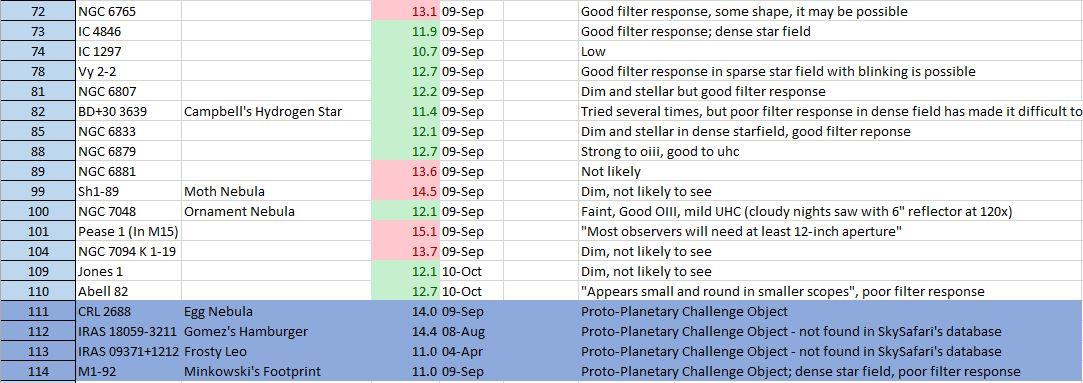

Blurb in March 2024 addition of Reflector showing I completed the program.
This page last updated on 9/17/2024 10:31:55 AM. If you have comments or suggestions, email me at webmaster@jscheetz.com